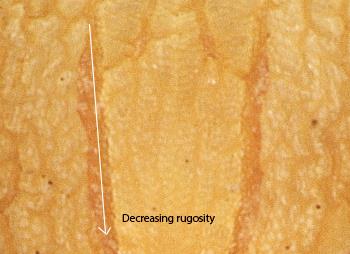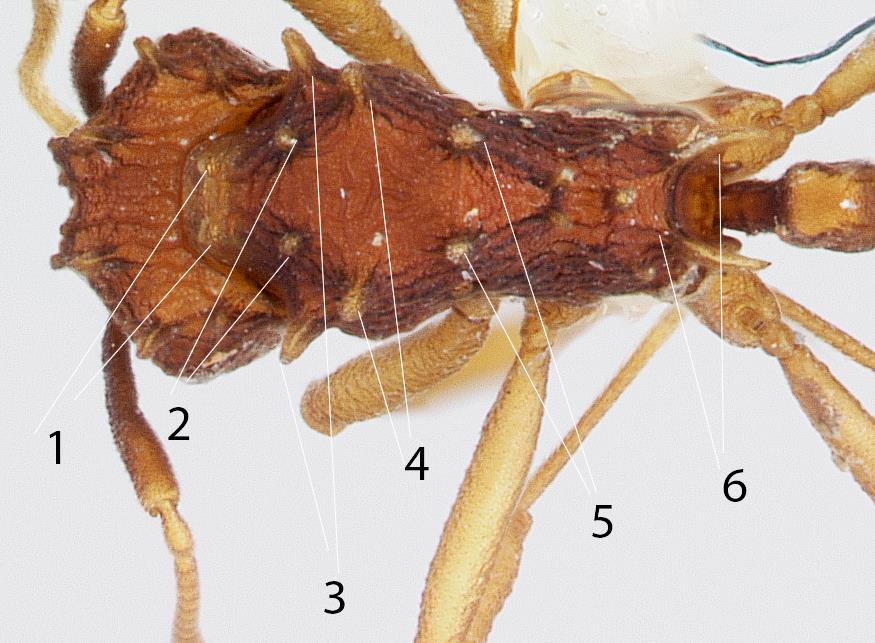
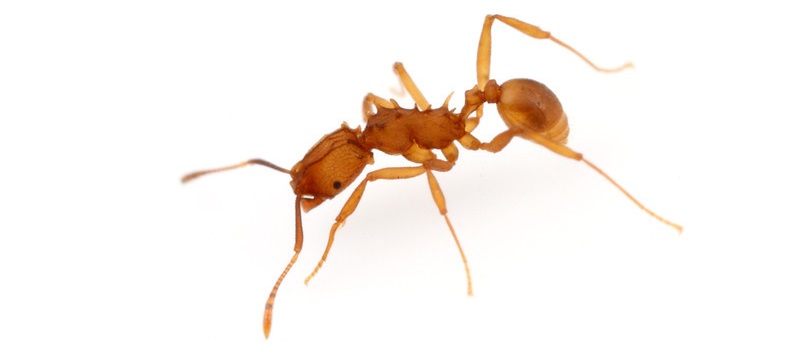


An Overview
Table of Contents
Proatta butteli is an ant (Hymenoptera: Formicidae) found in the forests of Singapore. It is at present the only species in its "genus".
This species is widely distributed in tropical Southeast Asia (SEA), ranging from southern Thailand to Indonesia (Sulawesi). It has been recorded in leaf litter and rotting logs in tropical rainforests. Though it has no official IUCN conservation status, its existence could be threatened by habitat loss.
Not very much is known about its biology, except for one published work [p1] who observed the behaviour of these ants at the Singapore Botanic Gardens (SBG). Moffet was brought by the National University of Singapore (NUS)’s then senior lecturer/ zoological ‘extraordinaire’, D. H. Murphy (inferred information – Moffet observed Maurauder ants Pheidologeton diversus in the SBG in the same year, mentioned in his book [p2]). Proatta butteli forages within a short distance of its nest. It is opportunistic and generalist as it hunts actively and scavenges on dead organisms as well. It is an important part of the ecosystem, by recycling nutrients back to the soil.
It is morphologically similar to the attine ants of the Neotropics, for both larvae and adult worker. The superficial similarity is a case of convergence, as shown by recent molecular phylogenetic work. Its placement the "tribe", Stenammini suggests that its phylogenetic position in Formicidae is not well established yet.polyphyletic

indicates that the media is interactive!
multimedia include: //Proatta butteli// Google Maps distribution | Leaf-cutter ant video | 'Spot the butteli' activity | Honeypot ant video


[1] General Information
Latin Name: Proatta butteli Forel 1912 INDONESIA (Sumatra)
Synonyms: None
Etymology: The genus, ‘Proatta’ seems to suggest a relation to the neotropical Leaf Cutter Ants (Comparisons with Attine Ants) , while its specific epithet ‘butteli’ is named after its collector, H. von Buttel-Reepen (Forel 1912) [p3].
Common Name: Pseudo Leaf-Cutter Ant (note: colloquial name coined by the author)
1.1 Distinguishing features (Diagnoses)
Ants have a ‘constricted waist’ (Figure 3b) and can be differentiated as such from other insects (class Insecta) and Hymenopterans. Worker ants do not have wings unlike most other hymenopterous insects ('order' Hymenoptera), with the exception of the females of Velvet ants (family Mutillidae).

Proatta butteli worker ant is tiny by human standards (refer to scale on Figure 3b) -- it is only approximately 2 - 3 mm long. To see the features described below you probably need a hand lens (while in the field). Alternatively, you may also catch the ant with an aspirator (only if you have an approved permit from NParks, in the context of Singapore) and bring it back to a laboratory for viewing under a microscope.
The following are its distinguishing features from other ant species in Singapore (note: these diagnoses only apply to the workers; for the larvae and other castes, refer to the Description):
- Head in front view (Figure 1a): presence of three circles arranged in a triangle at the frons; with two-clubbed antennae (though only weakly so, and not very obvious) with 12 segments (including the scape); antennal scrobes absent but frontal carina present [p4].
- Body in profile view (Figure 1b): dorsum of alitrunk with a series of six pairs of conical tubercles [p5]; a petiole and post-petiole, and presence of a sting at the end of the gaster (refer to Morphology).
.
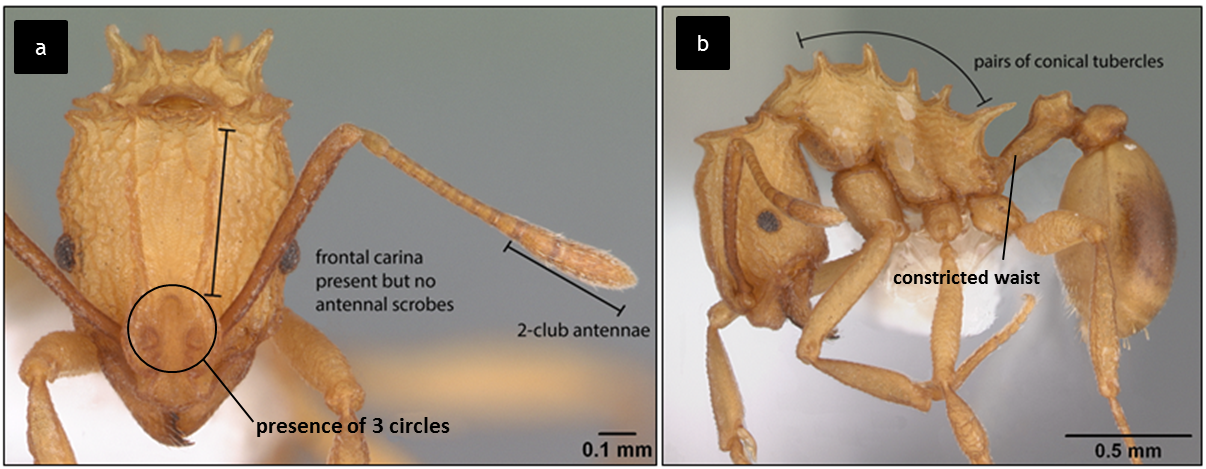
A universal ant key [p4] to the ant genera of the world (by biogeographic regions) is available, though a little outdated as compared to current genera-within-subfamily classification. The issue can be resolved by checking online databases such as AntWeb.
Have you seen Proatta butteli? Report it on iNaturalist.org!

1.2 Distribution

Proatta butteli ant is only recorded in the Southeast Asia [p6] though it may also be present in other parts of tropical and subtropical Asia (Figure 2).
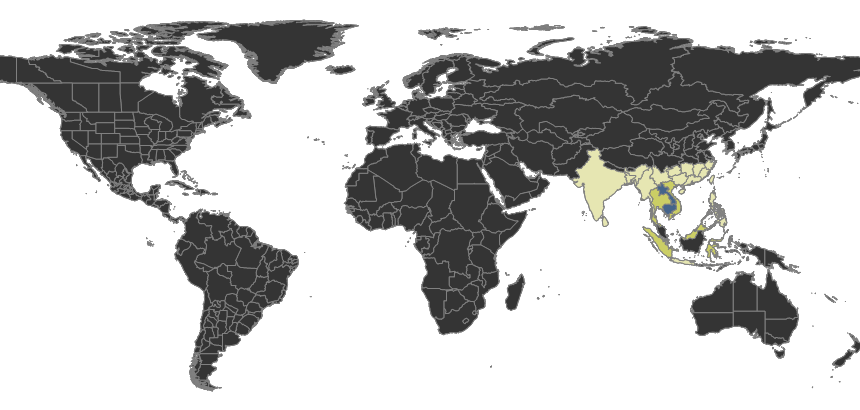
Figure 2. The distribution the genus, Proatta on a worldmap. The borders are based on countries. The green areas where it has been recorded, the blue areas indicate where it is highly likely present; the light green areas indicate where it might be present based on habitat similarity (Guenard, B. pers. comm.). (source: Ant Wiki Contributors, 2013 [e1]; Creative Commons Attribution Share-Alike)
Proatta butteli has been recorded in throughout the tropical Sunda shelf (Figure 2), including Vietnam, Thailand, Malaysia, Singapore, Sabah (East Malaysia), and beyond, in the Sahul shelf – Sulawesi (Indonesia) [e2, e3, p7]. The Sunda and Sahul shelves are biogeographic regions based on the delineation by the Wallace Line [p8] (Figure 3).
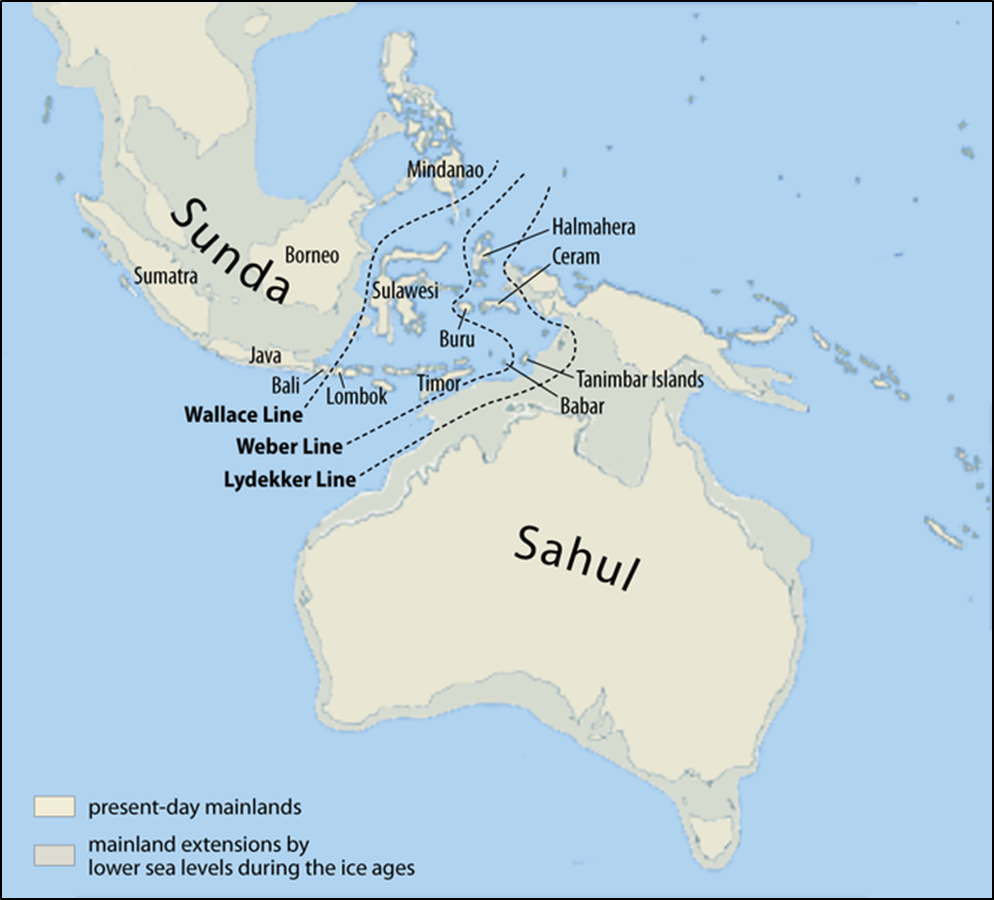

Return to Table of ContentsYou just finished section [1] General InformationThe next section is [2] Natural History & Biology


[2] Natural History & Biology
2.1 Ecological niche
2.1.1 Habitat
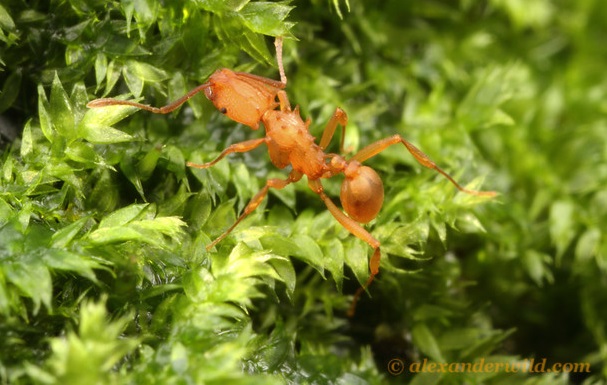
Figure 4. This individual was photographed at Danum Valley, Sabah (a national park in East Malaysia). (source: photograph by
© Alexander Wild (2010) [e5], used by permission)
 Within Singapore, it has been collected in the Botanic Gardens [p1], Bukit Timah Nature Reserve and in some parts of the Central Catchment Nature Reserve (Soh, E. J. Y., unpub.). This suggests that it is a species that prefers primary or mature secondary rainforest. It nests at the base of trees [p1]. Outside Singapore, it has also been collected in National Parks, where there are tropical rainforests.
Within Singapore, it has been collected in the Botanic Gardens [p1], Bukit Timah Nature Reserve and in some parts of the Central Catchment Nature Reserve (Soh, E. J. Y., unpub.). This suggests that it is a species that prefers primary or mature secondary rainforest. It nests at the base of trees [p1]. Outside Singapore, it has also been collected in National Parks, where there are tropical rainforests.2.1.2 Ecosystem services
Ants are known for their ecosystem services such seed dispersal, accelerating decomposition in bringing dead material in to the ground and aerating soil [p9]. Proatta butteli ant, which lives at the bottom of trees and lines its nest with woody frass and prey items [p1]. It is likely to play the role of a scavenger, helping to accelerate decomposition and recycle nutrient back into top soil when it brings dead materials back into its nest.

2.2 Biological characteristics and traits
2.2.1 The different castes

Ants are eusocial insects [p10]. The reproductive castes are the only castes responsible for reproduction, and there are typically more than two overlapping generations living together, and a worker caste is sterile (unable to reproduce) but helps out in a colony to care for the young [p11]. A typical Proatta butteli ant colony has worker, female reproductive (Figure 10) and male reproductive castes.
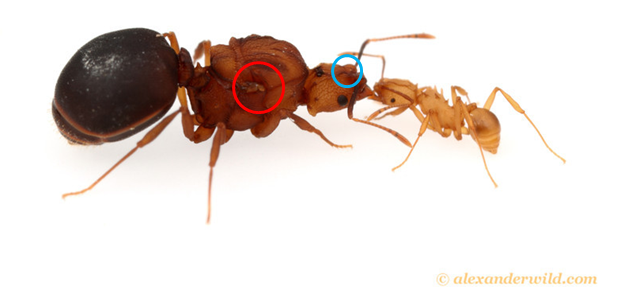
Ant worker: Ant worker castes can be monomorphic, dimorphic or polymorphic. The worker caste of Proatta butteli is monomorphic [p1]. As such, workers do not vary significantly in size and look different morphologically.
Gynes and males: The gyne or queen ant is distinguished from the worker ant where it has wing scars at the mesosoma (Figure 5). These wing scars are depressions previously occupied by the winged gyne, who sheds its wings after colony founding. In addition, Proatta butteli gyne has ocelli (or simple eye), which are hypothesized to help in flight stability [e9]. Male ants also have wings (Figure 6), ocelli and more eye facets. However, beyond that, the male ant is morphologically very different from the female reproductive (Figure 6). An important distinguishing feature from the female gyne and worker is that they have 13 antennal segments (including the scape) [p10].
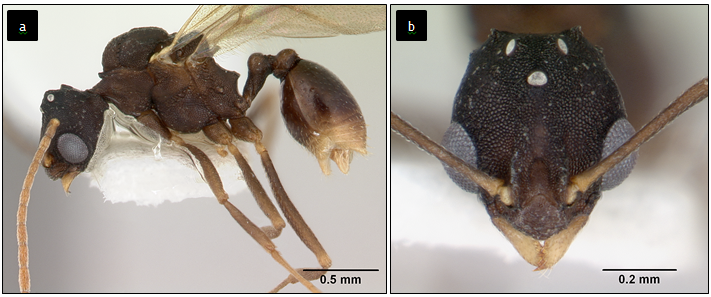
2.2.2 Life cycle and reproduction
Life cycle
There are larval (Figure 7), pupal and adult stages in their life cycle of all homometabolous insects. Ants undergo complete metamorphosis [p10] from the larval to pupal and adult stage. Some ants produce silk as larvae but ants of the subfamilies Dorylinae (army ants), Myrmicinae,
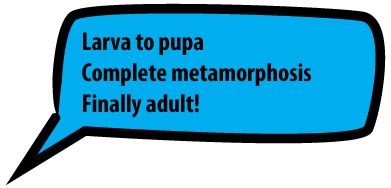
Dolichoderinae do not [p12]. Proatta butteli is a myrmicine ant. Similar to other ants of its subfamily, it does not produce a cocoon. Newly-emerged adults are known as ‘callow workers’. They are typically fainter, in colour and have softer integument [p10].
Only queen ants can lay eggs. Eggs which are fertilized give rise to females, while unfertilized eggs
give rise to males in a haplo-diploid reproduction system [p10]. Whether a larvae becomes a worker or queen is completely determined by the diet [p10].
Karyotype (=chromosome numbers) is unknown for Proatta butteli at present [p13].
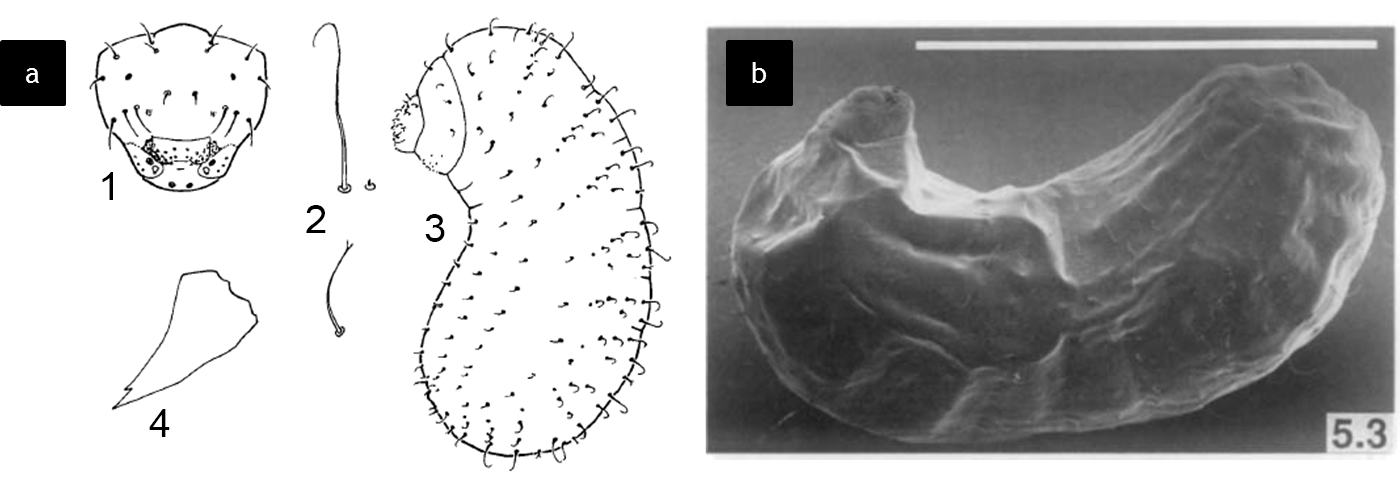
Reproduction

Ant colonies typically reproduce by two main different strategies: budding or swarming [p15]. Budding is where one of the multiple queens leaves her nest to form a new colony. This is usually the case when there are multiple queens in the nest. Swarming occurs when a timed, massive release of male and female reproductives occur. They mate and the male quickly dies.
The inseminated female gyne (the potential queen ant) sheds her wings and find a suitable place for her nest, and raise her first brood of worker. While it has not been documented in Proatta butteli, it is believed that this species has nuptial flights as well, since the reproductive castes are winged. As there are multiple queens in a nest [p1], it might be possible that it reproduces via budding where a queen from an active nest might leave to build a new nest. It might also be that inseminated females work together to make a common nest, similar to the Honeypot ant (Myrmecocystus mimicus) (YouTube video; below).

BBC's 'Empire of Desert Ants': Start watching at 1:50 where the Honeypot queen ants are featured (though, the entire documentary is quite interesting).
2.2.3 Life in the nest
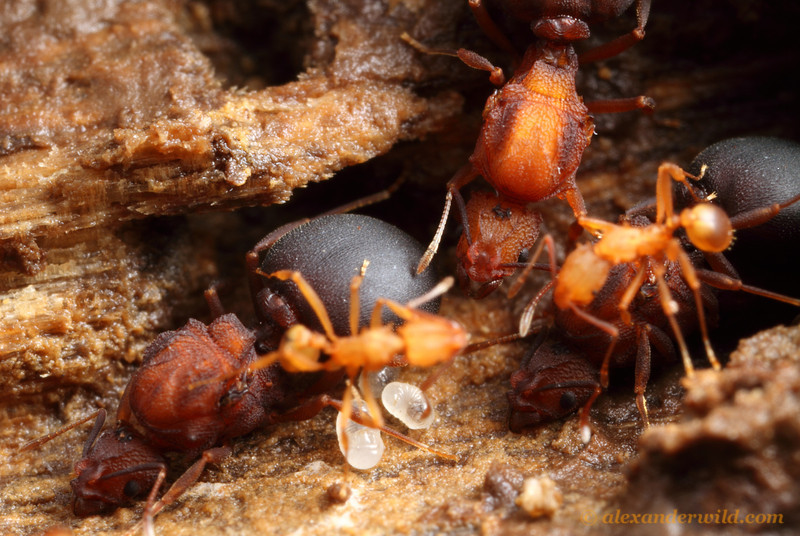
© Alexander Wild (2010) [e5], used by permission)
Aggression to conspecifics
Proatta butteli are ground-nesters. In the nest, the workers care for the larvae and pupae, feeding and transporting them around, and maintaining the nest, while the queens are responsible for laying the eggs. They have relatively large nests, of up to 10,000 ants in one nest with approximately one queen for every 100-500 workers [p1] (Figure 8). This phenomenon is likely to have implications on its behaviour. Studies have shown that ants of the same species (=conspecifics) but different colonies due to the recognition of specific (signature) hydrocarbons [p16], yet Moffet (1986) [p1] observed that when eleven Proatta butteli ants from a Malaysian population were put together with a Singaporean population, the Malaysian workers assimilated into the nest without any aggression.
 This is in contrast to other ant species (e.g. Formica japonica [p17]) which are aggressive to conspecifics not from their nest in response to difference in cuticular hydrocarbon composition. Could it be due to the poor recognition ability or are the ants not bothered by the difference in cuticular hydrocarbons? There is stronger evidence for the latter, since one would expect polygynous queens in the same nest to produce offsprings of different cuticular signatures.Both cases imply that the species is non-aggressive in general towards members of the same species, a trait appreciated in many invasive ants [p18] and often attributed to their success in establishing, dominating and becoming widespread (rather than isolated) away from their source population.
This is in contrast to other ant species (e.g. Formica japonica [p17]) which are aggressive to conspecifics not from their nest in response to difference in cuticular hydrocarbon composition. Could it be due to the poor recognition ability or are the ants not bothered by the difference in cuticular hydrocarbons? There is stronger evidence for the latter, since one would expect polygynous queens in the same nest to produce offsprings of different cuticular signatures.Both cases imply that the species is non-aggressive in general towards members of the same species, a trait appreciated in many invasive ants [p18] and often attributed to their success in establishing, dominating and becoming widespread (rather than isolated) away from their source population.Symbioses with other insects
Proatta butteli is likely to have symbiotic relationships with other insects. Excavated nests have been found in a decayed bamboo in the earth in company of many myrmecophilous crickets (family Gryllidae) [p19] and it also has been found with other ants in termite’s (order Isoptera) nests [p3] but these relationships have yet to be studied in detail or elucidated. These symbiotic relationships could be commensalistic, mutualistic or parasitic. Ant parasites are typically classed into three categories: alarming signals (usually for transient invaders), imitating ant host cuticular chemicals (i.e. blending in) or masking via phytomimesis to avoid detection (i.e. mimicking surrounding plants) [p20].
2.2.4 Life outside the nest
Foraging behaviour and recruitment
Older workers tend to forage outside, while younger, callow workers stay within the nest to perform nest-related duties [p1], a trend observed in other ant species as well [p21].
The Proatta butteli ant forages individually, either preying on other organisms or scavenging for dead insects [p1]. When help is required to pin down larger prey, it recruits other members of its colony to help [p1]. They typically forage near its nest, within a home range of about one metre and are found in high densities [p1]. Thus, ant workers are able to recruit quickly if required, via trail recruitment [p10] (as opposed to tandem-running) . This rapid recruitment system is made possible by the secretion of alarm pheromones by the Poison gland [p1].
They are also likely to be generalist scavengers and predators, since they do not have specialised mandibles which evolve as a result of a specialised diet, as seen in other ant species [e8].
2.2.5 Morphology and anatomy
Please note: this section might be rather technical, and as such, is only for the reference of those who might want to understand more about the morphology and internal anatomy of the Proatta butteli ant/ ants in general at greater depth
General exterior morphology
The general schematic morphology of the Proatta butteli ant is shown in Figure 9.
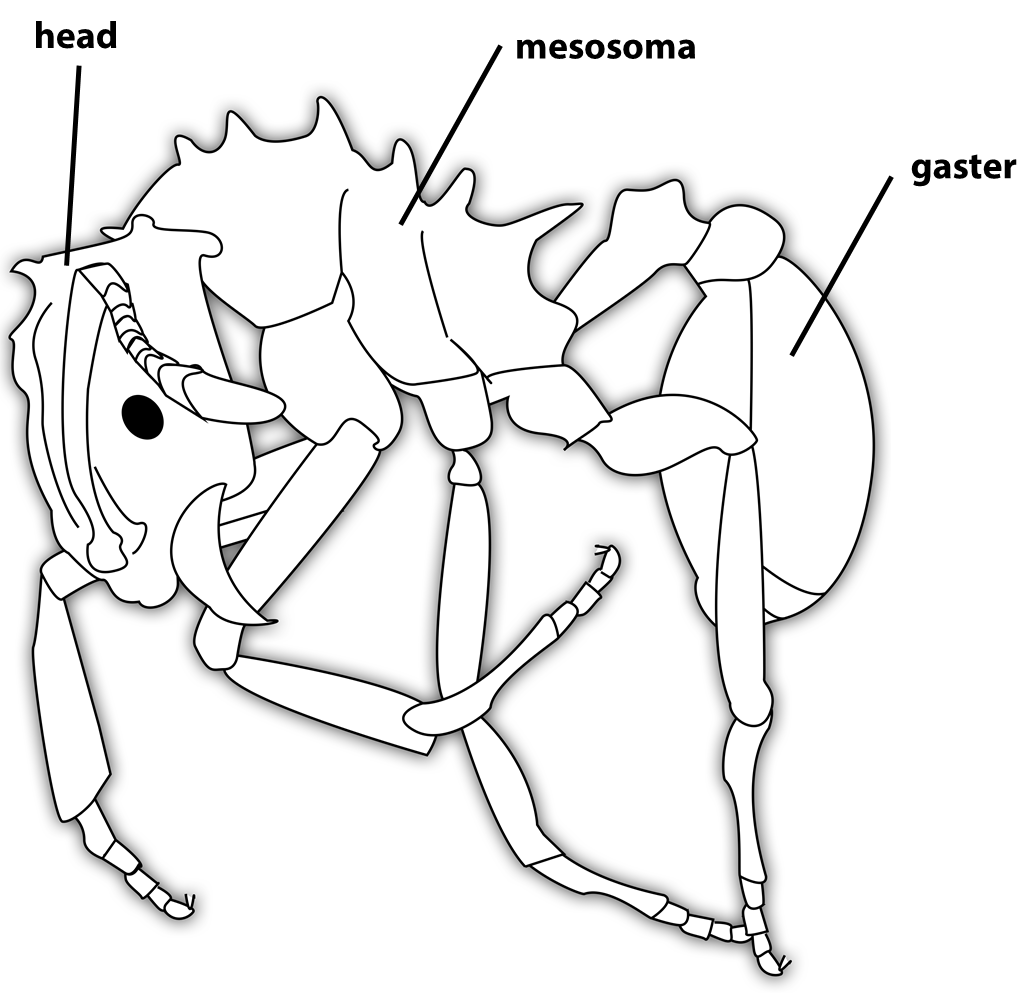
Thorax and abdomen: Only the worker ant morphology is shown here though certain morphological features might also be applicable to the other castes. In general, insects have three main parts, the head, thorax and abdomen. In ants, the ‘abdomen’ starts before the constricted ‘waist’. This segment is known as the propodeum. Therefore, ants use a different set of morphological nomenclature in most taxonomic literature. The ‘thorax’, together with the propodeum, forms the alitrunk. There are typically one or two nodes after the propodeum, which is known as the petiole and post-petiole (if present). The segment after the petiole and post-petiole is the gaster (Bolton 1995). More accurately, the propodeum is referred to as the abdominal segment 1 (A1), the petiole as A2, and the post-petiole as A3. Subsequent gastric segments are numbered A4 (or G1), A5 (or G2), A6 (or G3) and A7 (or G4) (Figure 10) (note: taxonomists are now more inclined to use the abdomen-based system of naming parts of an ant (Ward, P. S. unpublished)). Each gastric segment (A5-A7) is made up of a tergite (upper plate) and sternite (lower plate).
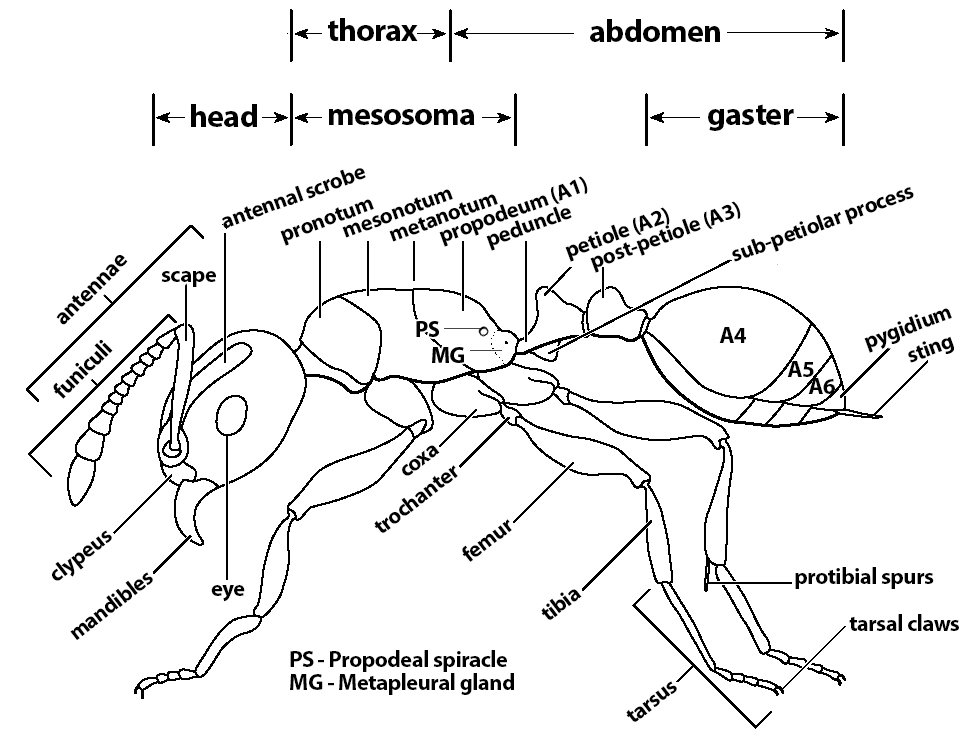
Legs: Each of the pro-, meso- and meta- (=1st, 2nd and 3rd) legs are split into six main segments: trochanter, coxa, femur, tibia, tarsus. Simple, non-pectinate tarsal claws and pro-tibial spur(s) are present as well in Proatta butteli. Spiracles present function as a respiratory system, exchanging carbon dioxide for oxygen in the atmosphere.

Head: The head is typically symmetrically-shaped and comprises of the antennae, eyes and mandibles (Figure 11a). Proatta butteli has a pair of long frontal carina, which leads up from the pair of frontal lobes to the top of the head but does not have antennal scrobes (Figure 11a). The antennae are bent, which is characteristic of ants. The antenna comprise of the first segment (scapes) and subsequent antennal segments, called the funiculus. The enlarged, last few segments of the antennae is known as the club. Proatta butteli has twelve antennal segments and a two-segmented club. The clypeus is the part of the head between the mandible and the rest of the head. It is separated into the lateral and median portions (=lateral clypeus, =median clypeus). The mandible of Proatta butteli is triangular with a edentate basal and dentate masticatory margin. Maxillary and labial palps hang from the labium on the underside of the head. (Figure 11b).
Internal anatomy
A general description of the internal anatomy of ants is described here (Figure 9) as the Proatta butteli species has not been studied in specific.
Ants have functional but simplified nervous, exocrine, circulatory, respiratory and digestive systems. The mesosoma houses important organs such as the heart, crop (“social stomach”) and gut [p10]. Ants also have a simplified nervous system ventral nerve cord and several ganglia (nerve cords) that runs through the body [p10]. The dorsal aorta pumps blood towards the head in an open circulatory system, without closed blood vessels [p10].
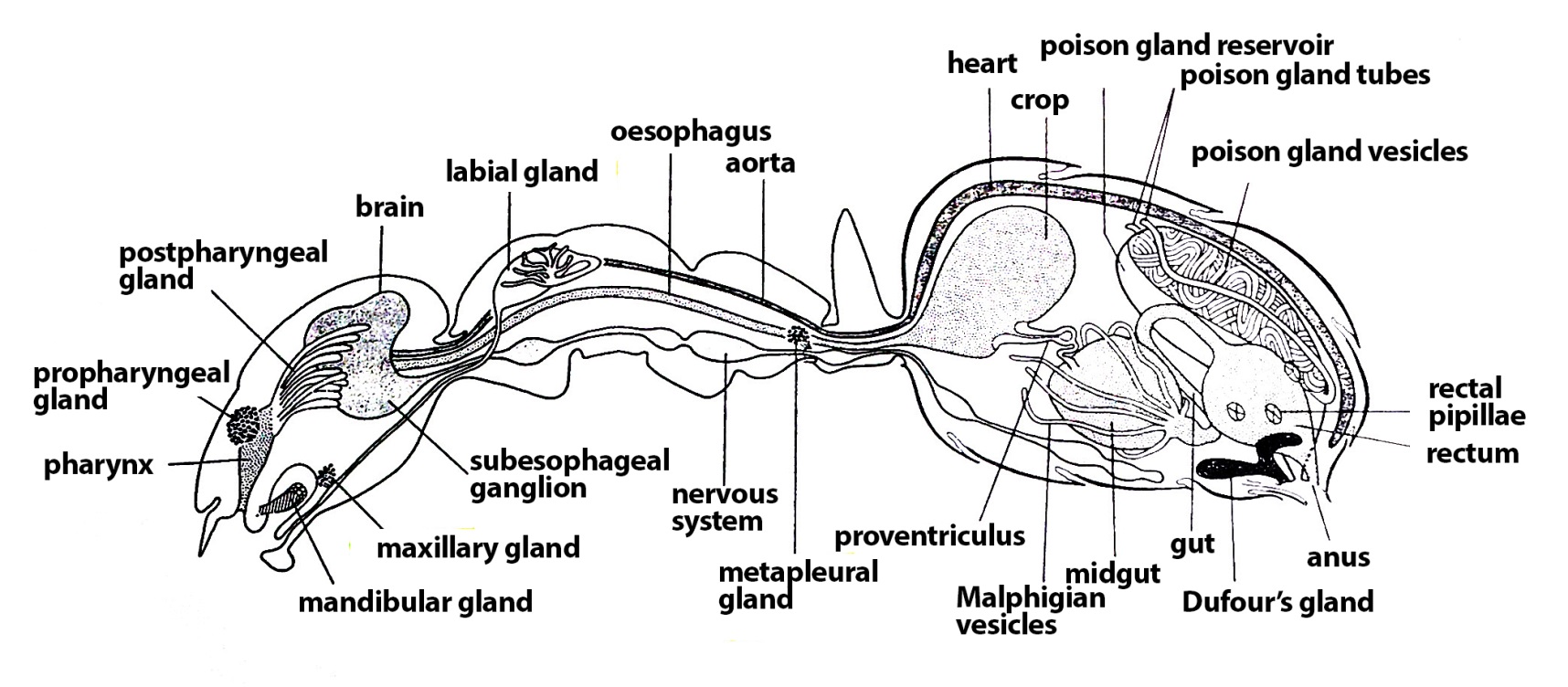
Exocrine system and glands present (information adapted from Hollobler and Wilson 1990 [p10] or otherwise cited)
The exocrine system is one of the hallmark of ant biology, since they are heavily utilized for intraspecific communication (e.g. alarm pheromone, sexual attraction) and defense. Certain chemicals discharged from the exocrine glands are signature, sometimes to the level of each species and even colony. It has been suggested that blends of chemicals released are complex. Functional roles of these blends have yet to be studied in Proatta butteli.
There are a few key exocrine glands, whose morphology, chemical make-up and/or purposes have been summarized by Holldober and Wilson (1990) [p10] and generalized for myrmicines:
- The mandibular glands of myrmicines secrete mainly ethyl ketones and are further accompanied by their corresponding carbinols, usually for defense and alarm communication.
- The metapleural gland serves as secretory function of antibiotic substances that coats the exoskeleton of the ants [p23] or to release alarm pheromones.
- The Dufour’s gland is typically a small gland at the base of the sting, near the end of the poison gland. It produces only alipathic hydrocarbons. The hydrocarbons are produced in a large variety for the myrmicines, including compounds such as methylundecane, tridecane, hexadecane, hexadecane and an array of farnesenses. These are suspected to have functions to alarm, recruitment and for sexual attraction.
- The poison gland apparatus typically consists of paired filamentous glands that converge into a single convoluted gland which in turn empties into a thin-walled sac like reservoir. It produces venom for defense, or sometimes also for recruitment and alarm substances. On morphological grounds, it has been assumed that myrmicines discharge the contents of the Dufour’s gland and poison gland separately.
- The pygidial gland is found on the 7th tergite with ducts leading between 6th and 7th tergite and has been shown to function as alarm pheromones.
- The sternal glands are present on the 7th sternite of the ant but are not homologous to the Pavan glands in other subfamilies.
Digestive system
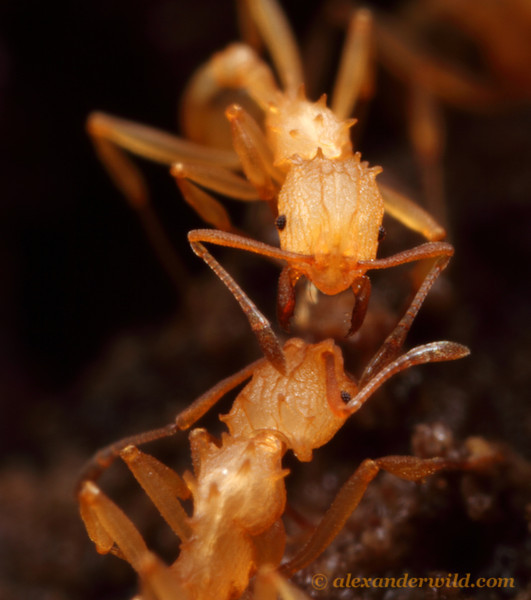
© Alexander Wild (2010) [e5], used by permission)
Ants share a ‘social stomach’ and this is done via stomopodeal (= oral) trophallaxis (Figure 13). The proventriculus is an organ to facilitate the social stomach. It regulates flow back into the midgut where food is digested [p10]. The infrabuccal pocket, a sizeable cavity that compacts most of the solid material that would otherwise clog the narrow, rigid proventriculus channel. Ants expel the infrabuccal waste material in the form of a pellet from time to time [p10].

2.3 Conservation status
At present, Proatta butteli has no IUCN Red List status [e11], likely due to the lack of data and also because the focus is typically on more enigmatic animals such as mammals, birds and dragonflies [e12]. However, with widespread deforestation ongoing in Southeast Asia [e10], the existence of P. butteli could be threatened due to habitat loss.

2.4 Comparison with attine ants ('tribe' Attini)
Please note: this section might be rather heavy on taxonomy and phylogeny. If one would like to find out more, please refer to the next section on "Taxonomy and Systematics" as well to complement this section.
The controversy – is it an attine ant?
 There was something subtly odd about the morphology of Proatta butteli when it was formally recorded by Forel (1912) [p3]. He remarked that it looked superficially similar to the ants from the 'tribe' Attini which share mutualistic relationships with fungus, especially like the two lower attine 'genera', Mycocepurus and Myrmicocrypta (Figure 14 and Figure 15 respectively).
There was something subtly odd about the morphology of Proatta butteli when it was formally recorded by Forel (1912) [p3]. He remarked that it looked superficially similar to the ants from the 'tribe' Attini which share mutualistic relationships with fungus, especially like the two lower attine 'genera', Mycocepurus and Myrmicocrypta (Figure 14 and Figure 15 respectively).The attines are a monophyletic group of ants strictly only found in the New World (North and Latin America) [p24], and include the widely-known Leaf-Cutter ants (Atta spp.), which use their mandible to cut pieces of leaves and carry like a flag on their heads, as they march back to their nests (YouTube video, below). They then feed these bits of leaves to their fungal gardens and in turn, harvest fat bodies (i.e. gonglydia) from their fungal-mutualists as food [p25] Further, these attines tend to have nest architecture touted great for biomimicry [e13]. It would certainly have been astounding if the Old World species was related to the attines.

National Geographic short videos: Leaf-cutter ants (Atta sp.) featured! They are indeed Lumberjacks of the insect world!
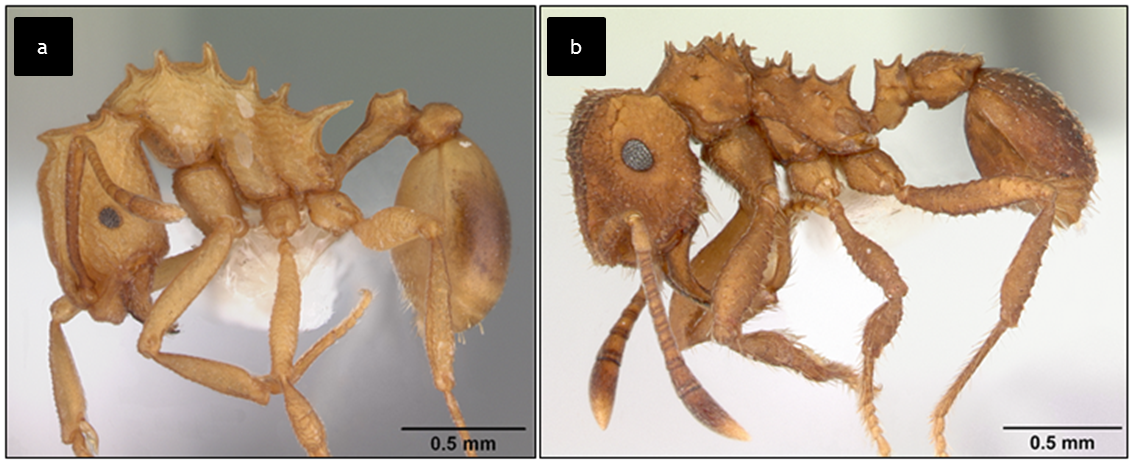
Figure 14. Proatta butteli (left) and Mycocepurus goeldii (right) in profile view. The features look superficially similar but are in fact, rather different on closer examination and are not likely to be homologous. (sources: (a) Ant Web (2013) [e2], image by April Nobile; catalogue number: CASENT0010836; Creative Commons Share-Alike Attribution; (b) Ant Web (2013) [e2], image by April Nobile; catalogue number: CASENT0173988; Creative Commons Share-Alike Attribution)
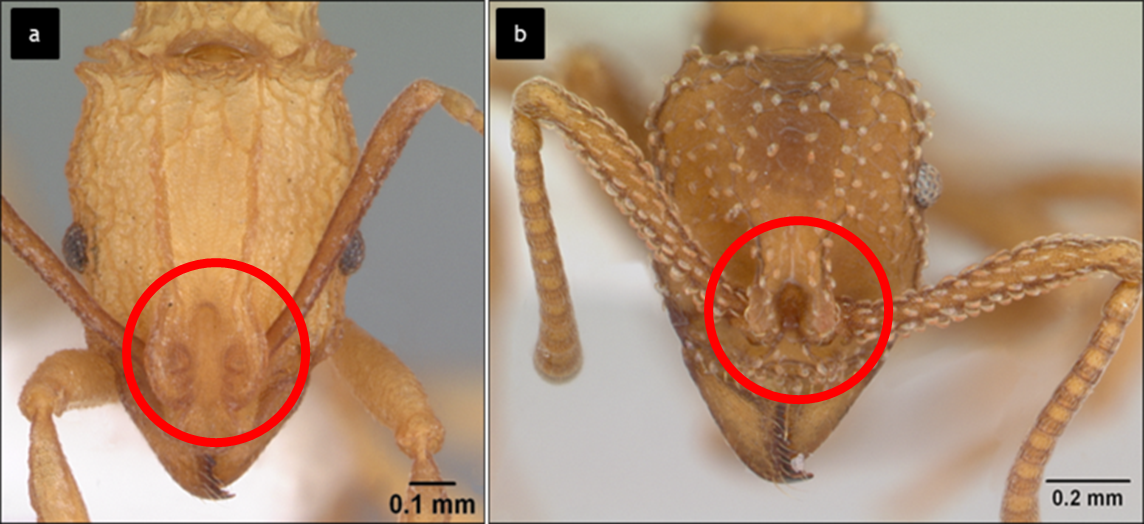
Figure 15. (a) Proatta in frontal view of the head and (b) Myrmicocrypta in front view of the head. Proatta has a pair of frontal carina that stretches all the way to the occipital corner (i.e. top) of the head, while the Myrmicocrypta does not have frontal carina. Further, the frontal lobes of Proatta curve in downwards to the median clypeus, while in Myrmicocrypta has frontal lobes that hang over the median clypeus. (sources: (a) Ant Web (2013) [e2], image by April Nobile; catalogue number: CASENT0010836 and (b) Ant Web (2013) [e2], image by April Nobile; catalogue number: CASENT0173990 (right); Creative Commons Share-Alike Attribution)
Dr. M. W. Moffet brought further controversy into this issue, when he gave G. C. Wheeler and his wife, J. Wheeler (husband-wife myrmecologists who specialised in the morphology of larvae) larval specimens. They made morphological comparison between the larvae of some of the attines and Proatta butteli [p14]. They concluded with much certainty that the monotypic 'genus' Proatta was attine though there was pressing evidence that showed otherwise. For example, “coarse spinules on the mandibles (of the larvae)” that was synapomorphic to most of the attines was missing [p14]. Moffet then proceeded to discuss the possibility of P. butteli related to the attines in his 1986 paper [p1].
Is it closely-related (sister-group) to the attines (and relatives)?
Next, Proatta butteli was found as a likely sister group by morphological cladistic analysis of the larva [p25] but the thoracic-abdominal articulation (character) of the P. butteli ant that was acknowledge to be in a ‘grey area’. Eight years forward -- in 2003, Barry Bolton, a prominent ant taxonomist, did a census of the entire Formicidae and classified Proatta under the 'tribe' Stenammini. In the monograph, he briefly compared morphological characteristics which did not qualify Proatta as an attine (see Bolton 2003 [p28]) except that Stenammini been shown by recent molecular work to be polyphyletic as well [p29]. Further molecular work by Schultz & Brady (2008) has also shown that Proatta is indeed distantly related to the attines whereas the attines were recovered as a monophyletic group via molecular phylogenetic trees. Lastly, Proatta do not share a mutualistic relationship with fungus, a trait synapomorphic to the attine ants [p31].
Wheeler and Platnick (2000) [p32] argue that “a cladogram can be obtained by analysing any single data set whatever; the only evidence that the relationships shown in the cladogram are not simply an artefact of the method is our ability to replicate the results – from a different data set for the same organisms”. The argument about convergence may be nullified if ant fossil that has many apomorphic characters to the two groups of ants is found, or increased character sampling is done via (1) morphological work of other ant castes (males in particular) to show synapomorphic traits, or (2) further genomic or transcriptomic work.
Could the 'similar' features be a case of plesiomorphic characters or is it just purely convergence?
The similar features are thus a interesting case of convergence, as Weber (1958) [p33] postulated. The features of the workers (tubercles at the head and mesosoma and frons) do not seem homologous in the first place on closer examination to the attine ants, and are more likely to be independently developed. Perhaps it is because both ants live in similar environments of the tropical rainforest, though it is not certain what advantage the protrusions on the mesosoma confer.
At present, this is an example of how homoplasy can trick one into believing the species is closely related while it is not. As Ward (2007) [p22] highlights, “it is becoming increasingly apparent, however, that some aspects of worker morphology show a strong tendency towards convergence, making it challenging to infer phylogenetic relationships from morphological characters alone”. Thus, they are not likely to be attines or closely-related to the attines based on current evidence based on biogeography, the lack of synapomorphic traits to the attine ants, morphological [p28] differences, high likelihood for homoplasy and DNA phylogenetic trees.
For a summary of the classification changes, refer to Taxonomic treatment of genera.
(source: photographs by © Alexander Wild, used with permission)Click on the correct Proatta butteli!
Did you manage to get it correct on the first try?

Return to Table of ContentsYou just finished section [2] Natural History & BiologyThe next section is [3] Taxonomy & Systematics


[3] Taxonomy and Systematics
Please note: Ranks are used only for the convenience of the discussion about monophyletic groups as it is frequently used in the literature (taxonomic papers and monographs). Quotation marks have been added to the ranks.
3.1 Phylogenetic position
Overall, both morphological and DNA characters have been used to classify the ants under a phylogenetic framework. They are largely synonymous at the 'supra-subfamily' level but not at the lower clades (e.g., some 'subfamilies', 'tribe', 'tribe-group' level) with each other as shown in two prevailing opinions by Bolton (2003) [p28] and Brady et al. (2006) [p29], morphological-based and DNA-based (seven nuclear genes, 162 taxa) respectively. A recent review of ant phylogenetics and taxonomy was done [p22], who said that ‘Bolton’s (2003) [p28] monograph provides a very useful framework for testing and refining phylogenetic hypotheses, and for designing appropriate taxon sampling schemes in molecular studies’.
Most of ant systematics at the 'subfamilial' level and below the 'subfamilial' level, however, remains is uncertain [p22]. For example, ant 'genera' is Proatta more closely related to has not been formally and phylogenetically analysed. Oddly enough, most 'genera'-based delimitations are considerably ‘more stable’ and likely to be monophyletic [p22]. The subsection on phylogenetics at higher level illustrate how the ants are related to other hymenopterans and highlight the advances in phylogenetics that result in well-resolved trees.
Taxonavigation of Proatta butteli:
|
Animalia > Arthropoda > Insecta > Hymenoptera "Tribe-group" (Bolton 2003): solenopsidine Genus: Proatta Specific epithet: butteli |
At the “genera” and “tribal” level: It is a monotypic 'genus' (i.e. only one species) and in 'tribe' Stenammini [p28]. The 'tribe' Stenammini includes the following 'genera': Ancyridris, Bariamyrma, Calyptomyrmex, Cyphoidris, Dacatria, Dacetinops, Dicroaspis, Indomyrma, Lachnomyrmex, Lasiomyrma, Lordomyrma, Proatta, Rogeria, Rostromyrmex, Stenamma, Tetheamyrma, Vollenhovia but is likely to be polyphyletic [p29], suggesting that the systematics of these presumably closely-related ants need to be relooked at. A phylogenetic tree via Maximum Parsimony (PAUP, with 100 bootstrap replicates) on PhyloTA based on 28S ribosomal RNA [p30] has revealed that Proatta butteli is most related to Lordomyrma (Figure 16). Bootstrap values were however not reflected on the tree and thus it is unknown to the reader whether the tree is well-supported. Ideally, more genetic sequences should be concatenated and compared, and more species be represented. It was also suggested [p22] that ‘establishing a phylogenetic classification of …Myrmicinae that is underpinned by well resolved and well-supported trees will require much more extensive sampling of taxa and genes’.
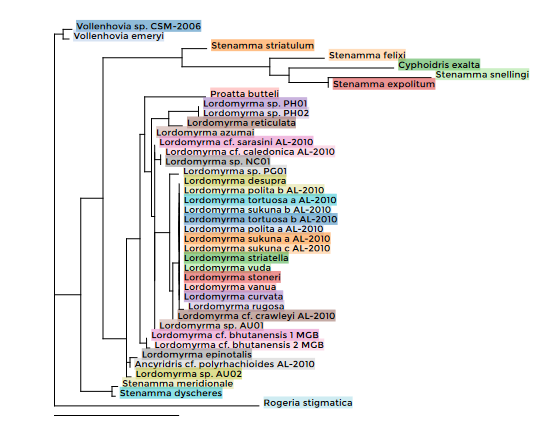
Relationship with the attines: Its last common ancestor with the attines dated 58 MYA based on a phylogenetic tree (node support: 84/63/99/82 for parsimony bootstrap/ ML bootstrap/ Bayesian nucleotide-model posterior probabilities/ Bayesian codon-model posterior probabilities optimality criterion) (Figure 19) [p27], suggesting that they are rather distantly related. However, is there reason to believe the estimated time based on current geological knowledge? The most recent geologic time where North America and Asia was connected, was supposedly 200 MYA as Laurasia, and which split approximately 200 – 180 MYA into Laurentia and Eurasia [p34].
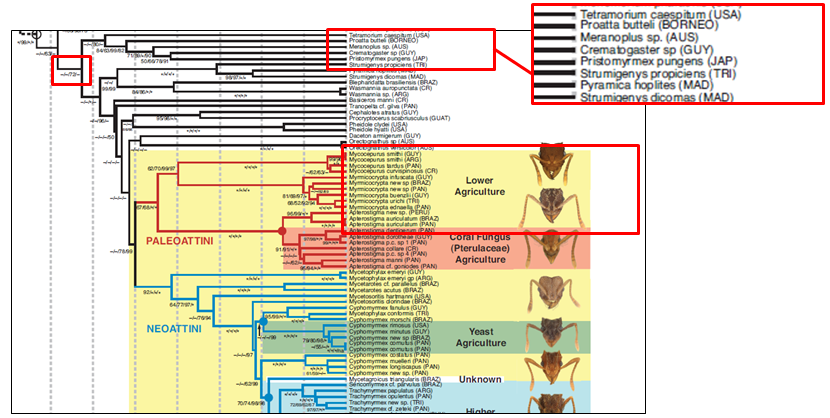
"Subfamilial" positions: Extensive work has been done in sequencing certain ant genes in the various genera and thus has been well-represented in terms of DNA barcodes (refer to Figure 20a for the mitochondrial CO1 gene), ranging from genes such as CO1 mitochondrial DNA; abd-A, wnt-1, LW Rh and EF-1a DNA; 28S ribosomal DNA and 18S ribosomal DNA (see Proatta butteli GenBank records as an example) to elucidate relative 'subfamilial' relationships (Figure 18a). 90% of the valid ant species fall within the formicoid clade [p22]. The formicoid clade is split into five main, monophyletic groups, (1) dorylomoprhs, (2) myrmeciomorphs, (3) dolichomorphs, (4) ectaheteromorphs, (Figure 18b). However, Proatta belongs to Myrmicinae subfamily, which is currently not established as monophyletic, and whose position in the phylogenetic tree is currently polytomous with Formicinae and two other extinct clades with subfamilial ranking (Figure 20b).
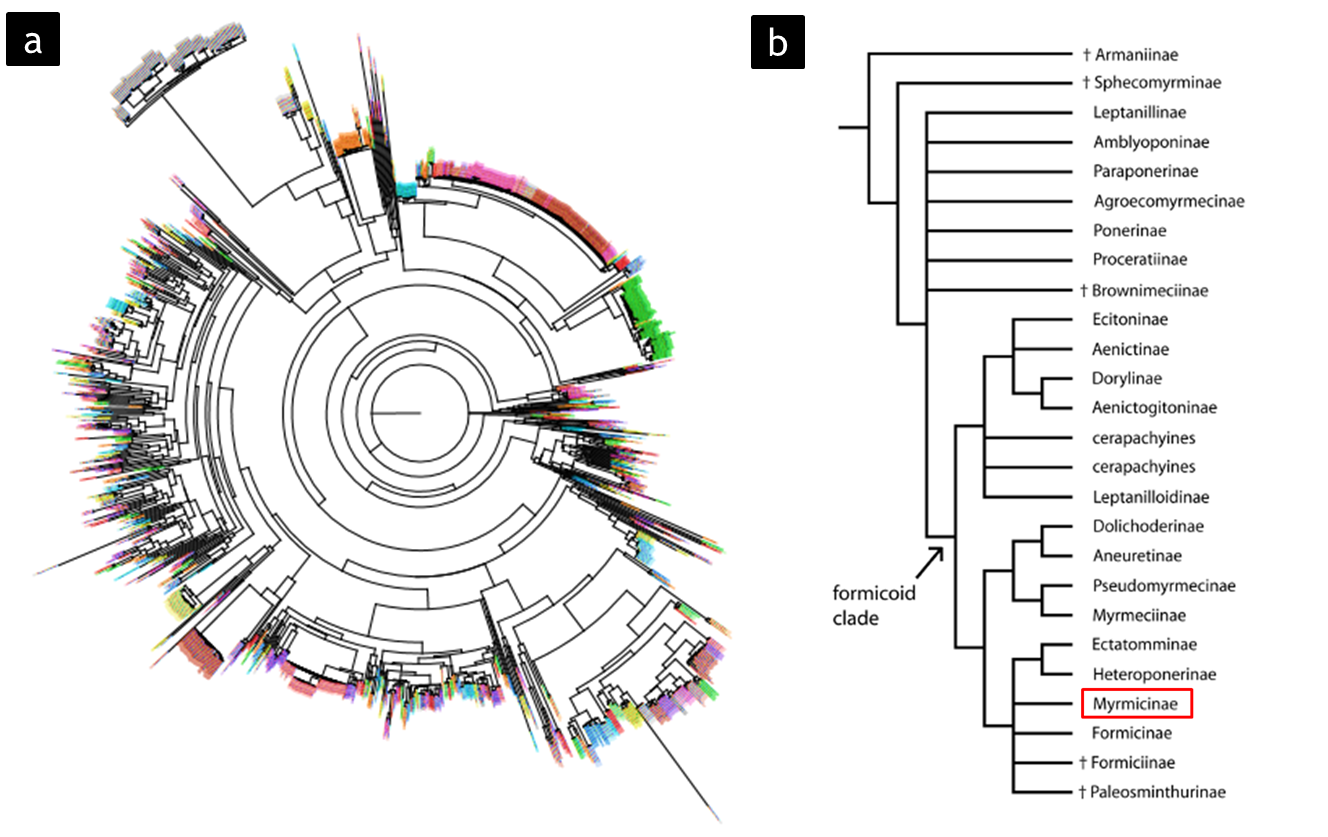
Formicidae as a monophyletic group: Formicidae is a diverse group of insects, with approximately 15,000 extant species and subspecies present (Ant Web 2013). Morphological and behavioural synapomorphies show that (at least most of) Formicidae is well supported as a monophyletic group [e16].
Ants and other Hymenopterans in Aculeata: A recent paper [p35] used Next-Generation sequencing transcriptomic data of 18 species to yield a well-resolved tree with high bootstrap values. The relationships within the Aculeata clade has been disputed and is in contrary to prior prevailing opinions (Figure 21a and b). More specifically, it has to do with the position of the groups nested within Vespoidea and Apoidea. Originally nested within Vespoidea (a group containing mainly ectoparasitoid wasps), the ants might instead be a sister group to a group containing spheciform wasps and bees (Apoidea) instead (Figure 21b), as suggested by the paper.
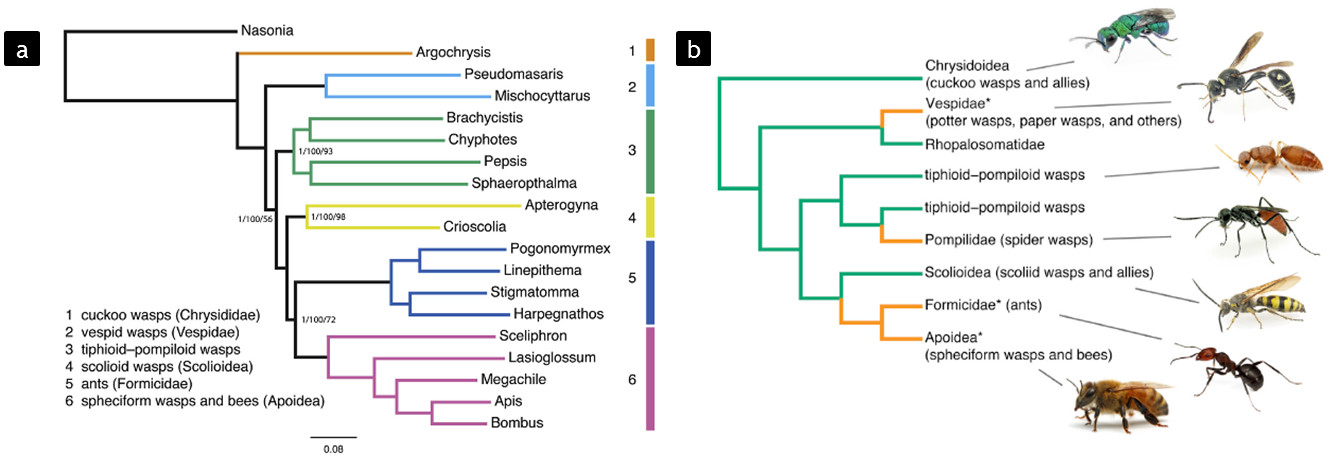

3.2 Descriptions
3.2.1 A short commentary
Status of description for the castes and ontogenic forms: A full description of all the castes and ontogenetic forms are crucial for characterising an ant species. This is often challenging, as the nest usually must first be located and destroyed. Male ants are additionally harder to obtain as they are only produced when the colony is at the reproductive stage, typically excluding very young colonies. Further, the male ant morphology is not well studied [e18].The male and worker of Proatta butteli was the first described by Forel in 1912 [p3]. Crawley (1924) [p19] described the gyne. Wheeler and Wheeler (1985) [p14] described the larvae of Proatta butteli and Moffet (1986) [p1] also described the gyne. These are summarized in ‘Original Descriptions’. Thus, the complete caste (gyne, male and worker) and life cycle (adult, larvae) has been described except for the pupae.
Comments about the original and subsequent descriptions: Descriptions written by curators, naturalists and sometimes even scientists, are not the most useful or meaningful when used to identify these ants for the taxonomist and layman alike, as they can be long and lengthy but yet sometimes also uninformative because it is vaguely written. They are typically more useful as reference for taxonomists to trace where physical (especially type(s)) specimens can be found. They are compiled in this Wiki from various sources for keepsake purposes and reference.
The descriptions for Proatta butteli are not the easiest to decipher for practical usage. The worker and gyne description by Forel (1912) [p3] is less informative as they are very short and not sufficiently descriptive of the respective ant castes, while the description by Crawley (1924) [p19] is rather descriptive but with no standard morphometric measurements. The description by Moffet (1986) [p1] is a standalone of the gyne but makes comparisons to the worker and males which were not described in the paper. Further, he did not make comparisons with the type specimen. Larval description by Wheeler and Wheeler (1958) [p1] seems detailed and viable for usage. Unfortunately, the larval caste is often not obtained, any way, in typical field methods unless a nest (for ground-nesting ants) is excavated.
A few of these descriptions include colour as a character. It should be noted that colour is not a good indication of the taxonomic status as the colour of holotype specimens may fade over time, and it is highly variable in certain species – and also in this species (and thus is not a reliable trait to use to delineate a species as it might be highly influenced by the environment). However, describing the colour of a freshly-obtained specimen might be a useful piece of information. Some of the descriptions are also written in languages other than English -- such as German, which adds to the difficulty of understanding these descriptions if one does not know one of the languages used.
Current practices in ant taxonomy: Current-day descriptions by ant taxonomists use a range of standard morphometrics (Table 1), a quantifiable way to use morphology to delineate species. These are also accompanied by qualitative descriptions of sculpture and unique features present. These morphological features are used as an indirect indicator of species-level difference and are typically published as a generic revision with a species key. Such a method would likely complement most species concepts but may be biased against revealing 'cryptic species'.
Table 1. Standard morphometric measurements for ants. Adapted from [p38] and [p39].
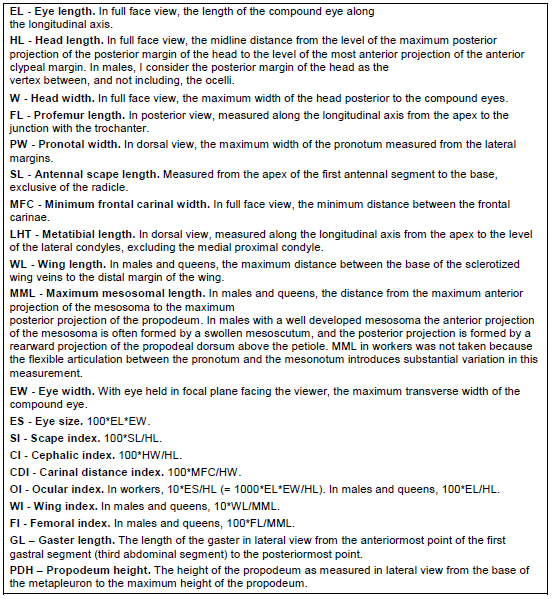
3.2.2 Original description and subsequent descriptions
Worker (female sterile caste)
Forel (1912) in GERMAN [translated from German via Google Translate]: “Length 2.2- 2.5mm. The rear epinotum are only slightly shorter than the basal surface of the epinotum. The probe shaft extends beyond the back of the head by a little more than its thickness. Light brownish-red, a very broad transverse bandin the middle of the abdomen - brownish.”
SPECIMEN EXAMINED: Syntype collected by Forel in 1912 (Sumatra, INDONESIA)
Gyne (female reproductive caste)
Crawley (1924) in ENGLISH: “Length 4.5 mm. Dark reddish brown; mandibles, clypeus, frontal carina, anterior of mesonotum, wing-insertions, apical segments of gaster, legs, and antennae ferruginous. Wings fuscous. Pilosity almost nil. Head with mandibles in the form of an almost equilateral triangle, much broader behind and narrower in front than in the worker. Broader than long without mandibles. Occipital border concave. Mandibles narrow, with three acute teeth at apex followed after a space by a broad blunt tooth near the base. Frontal carinae shorter and wider apart, and the teeth on the occiput blunter. The scape just passes the occiput. Eyes prominent, placed below the middle of the sides. On the vertex is a prominence rising into two short longitudinal ridge, concave between; the anterior ocellus is placed in front of this prominence, and posterior ocelli at each side of the lateral ridges.
Thorax massive, the scutum roughly forming a square (subjective) when looked at from above; laterally the pronotum has a pair of blunt spines, one above the other. Anteriorly the mesonotum has a short longitudinally impressed line and two wide ridges, which converge near the centre. Sculletum prominent; it is slightly concave from side to side, with a central ridge. Metanotum with a central blunt spine (Forel, in his description of the worker, speaks of this spine as belonging to the epinotum). Epinotal spines short, broad at base and acute at apex, curving slightly inwards. In profile the declivity equals Is the base, both concave. Pedicel as in the worker but broader and shorter. Gaster large and oval, the basal border feebly sinuate. The basal segment covers nearly the whole gaster. Head longitudinally and densely reticulate-rugose; pronotum transversely so: rest of thorax similar to the head. Bases of epinotal closely striate. Pedicel transversely rugose. Base of gaster longitudinally reticulate-striate, rest of basal segment closely striate. In addition, the whole body has a microscopic ground-reticulation.”
SPECIMEN EXAMINED: Non-type collected by Crawley in 1924 (Sumatra, INDONESIA)
Moffet (1986) in ENGLISH: “Total length about 6 mm, with little size variation. Head width of three Singaporean gynes 1.05-1.06 mm; head length 1.08-1.10 mm; cephalic index 96-98. Head similar to that of worker, but roughly triangular in full face view; eyes oval, maximum diameter about 20 % of head length; ocelli prominent; mandibles and antennae as in worker. Trunk massive, with full complement of flight sclerites, and only about 25% longer than high; very similar in shape to that of Atta gynes. Metanotum with a single blunt spine medad, as in male. Petiole and postpetiole as in worker. Gaster heavily sclerotized, massive, of a length slightly greater than that of alitrunk. Head and alitrunk areolate-rugose (with alveolate microsculpturing) as in workers but more strongly impressed.”
SPECIMEN EXAMINED: Non-type collected by Moffet in 1983 (INDONESIA) and 1983 (SINGAPORE)
Male
Forel (1913) in GERMAN [translated from German via Google Translate]: “Length 2.5 mm. Probe shaft much longer than the head. Head upside down trapezoid, narrow rear and front wide, longer than wide, narrowed at the forefront. The eye stake only 1/8 of the head sides. Abdomen well as broad as the head. Color quite brownish, with lighter antennae and legs. Incidentally, like the female worker with the specified class features. External genital flaps oblong, rounded at the tip. Wings pubescent, slightly brownish dyed.”
SPECIMEN EXAMINED: Syntype collected by Forel in 1912 (Sumatra, INDONESIA)
Larvae
Wheeler and Wheeler (1958) in ENGLISH: “Length (through spiracles) 2-2.6 mm. Profile attoid. Spiracles small, decreasing slightly posteriorly. Integument with rather long rows of spinules. Body hairs sparse; generally distributed. Of 3 types: (I) 0.025-0.1 mm long, unbranched, smooth, slender, with tip more or less curved; (2) about 0.025 mm long, few, with bifid tip; (3) about 0.006 mm long, unbranched, smooth, few, on venter of thorax. Cranium subheptagonal, about 1 ½ times broader than long. Antennae just above midlength of cranium; minute; with 3 sensilla each. Head hairs few; 0.013-0.056 mm long, unbranched, smooth, lightly curved. Mouth parts small. Labrum trilobed; anterior surface of each lateral lobe with 2-3 ensilla near ventral border; middle lobe with a cluster of 3-4 sensilla near each ventrolateral corner. Mandible amblyoponoid; moderately sclerotized; moderately stout; apex a short slender tooth; a small subapical medial tooth. Maxilla adnate; subovoidal in anterior view; palp a small skewed peg with 5 (1 apical, 3 subapical and 1 basal) sensilla; galea a slender frustum with 2 apical sensilla. Labial palp a slight elevation with 5 sensilla; an isolated sensillum between each palp and the opening of the sericteries; the latter a short transverse slit.”
SPECIMEN EXAMINED: Non-type collected by Moffet in 1983 (SINGAPORE)
3.2.3 A tentative description
Distribution: Proatta butteli is a widely distributed ant species (Distribution), its allopatric populations might have been separated for a period of time (e.g. the populations of “Vietnam/Thailand/Singapore/Malaysia/Sumatra”, “Sabah” and “Sulawesi”; or the “Sahul shelf” and “Sulawesi” populations) and might have undergone speciation, expressed indirectly via the morphological traits.
Hypothesis: Overall, the species is rather widespread but not abundant where it is found, as it is not collected very often. As there has not been extensive study on the taxonomy of this genus and species (perhaps due to its rarity), it might be possible that the widespread Proatta butteli has undergone allopatric speciation since dispersal of these ants are rather localised and episodic (see ‘Reproduction’) though it would be almost a herculean task to show it so via the Biological Species Concept since every pairwise population interbreeding experiment must be done. However, if a population with deviance in morphology is strong, it could be used as a proxy to show that these populations are reproductively isolated and thus, speciated. This is subjected to more taxonomic studies of the species but is not within the scope of this Wiki page.
Methods: The section below could be used as a tentative description, written by the author (Eunice) based on Ant Web specimens that have a digital image tagged to it. Standard morphometrics (Table 1) were measured from the images on Adobe Photoshop CS6, assuming that there is no distortion in the microscope images. Most of the specimens are not type specimens but have been identified by an ant expert. Sculpture described was used with reference to Harris (1979) [p37]. Morphological features which were not parallel to the image were not used, since it would not be accurate to the scale. It is a limitation of this image-based method and thus, also, the morphometric measurements might be prone to some error.
Limitations: Male, queen and larval specimens are not described due to the author’s limited knowledge about the morphology of these respective castes or ontogenetic forms. One might like to refer to 'Original Descriptions' instead.
*note: if new descriptions are available, it can be updated on this Wiki in the future
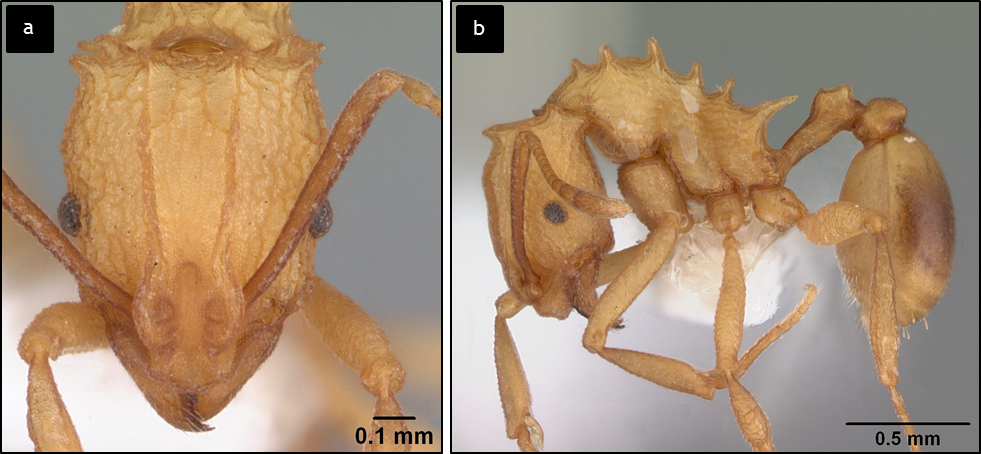
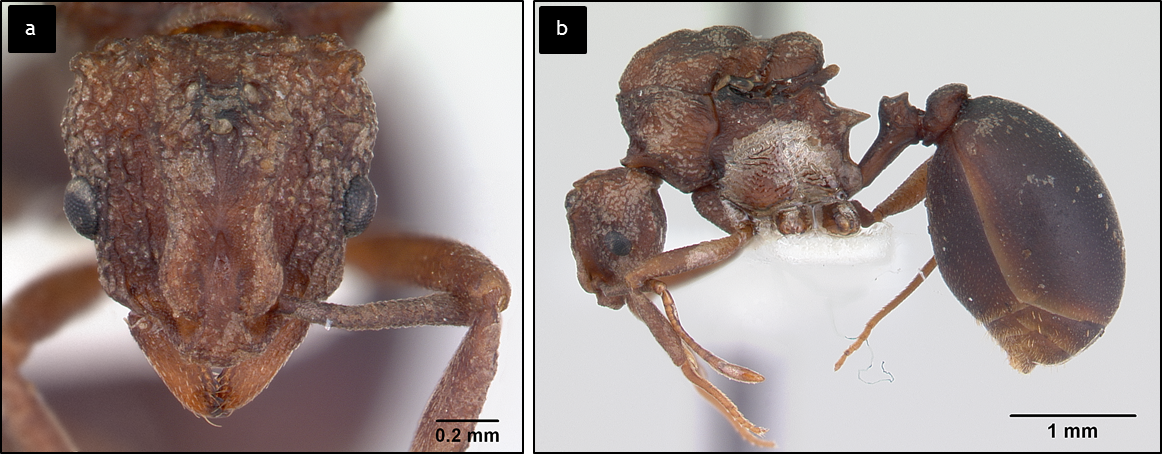
Figure 22. Proatta butteli dealate gyne. (a) frontal view of head, (b) profile view. (source: Antweb (2013) [e2], image by April Nobile; catalogue number: CASENT0178530; Creative Commons Share-Alike Attribution)
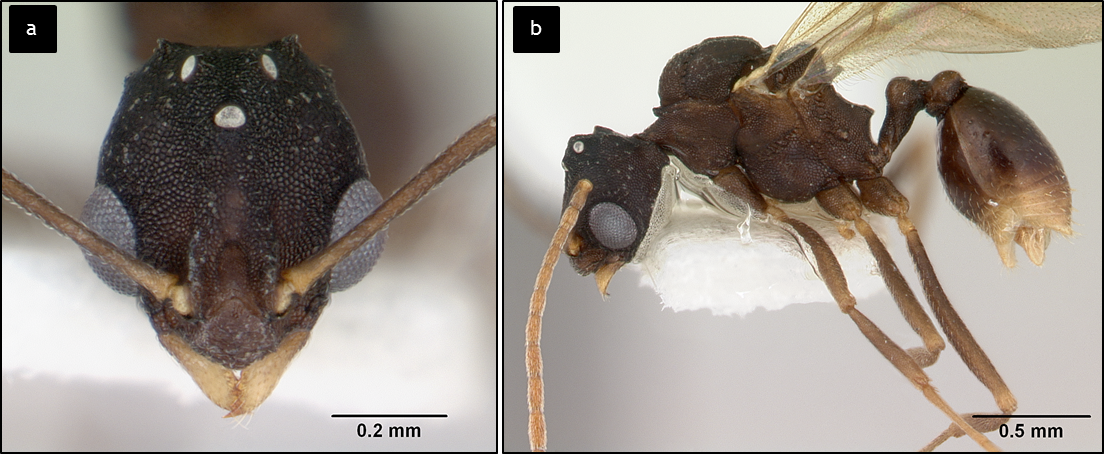
Figure 23. Proatta butteli male (a) Head frontal view, (b) body in profile. (source: Antweb (2013) [e2], image by April Nobile; catalogue number: CASENT0178527; Creative Commons Share-Alike Attribution)
Worker.
|
Head 12 antennal segments with a two-segment club though this is weakly developed. Frontal carina present, extending down linearly from two tubercles at the occipital corners before it forms a convex and touches the clypeus. Occipital corners also with two other pairs of tubercles, present at the anterior and posterior, formed equidistant from the midline of the head. Frontal lobes present. Three circles arranged in a triangle at frons of clypeus. Sculpturing on head generally rugoreticulate though rugosity decreases on the region between the two frontal carina when extending down from the occipital end of the head (Figure 14). Microsculpturing is aveolate. A clear basal and apical margin on mandible; apical margin with four teeth with a break in between the third and fourth starting from the apical-most (Figure 15). |
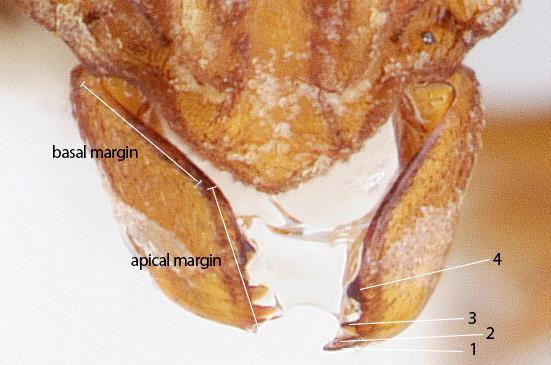
|
Mesosoma [Pronotum (T1), Mesonotum (T2), Metanotum (T3), Propodeum (A1)] Mesosoma with six pairs of tubercles (Figure 16), asymmetrically distributed along the median line in profile. The last pair of tubercles are long and curved towards each other. Rugose sculpture on the mesosoma. Aveolate microsculpturing. Petiole (A2) & Postpetiole (A3) Long peduncle present. Squamiform petiole with a groove, resulting in a posteriorly-pointing notch (Figure 17). Legs Pro-, meso-, meta- femur with similar rugose pattern (Figure 18). Presence of a pectinate protibial spur. Tarsal claws not toothed. Gaster (A4 – A7 [=G1-G4]) Postpetiole attached in between the 1st tergite and sternite. A very broad transverse band in the middle of the gaster. |
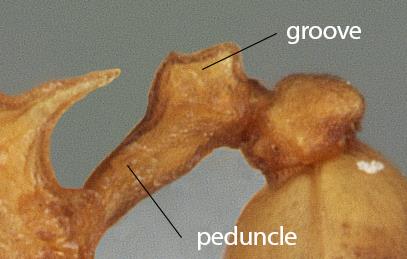
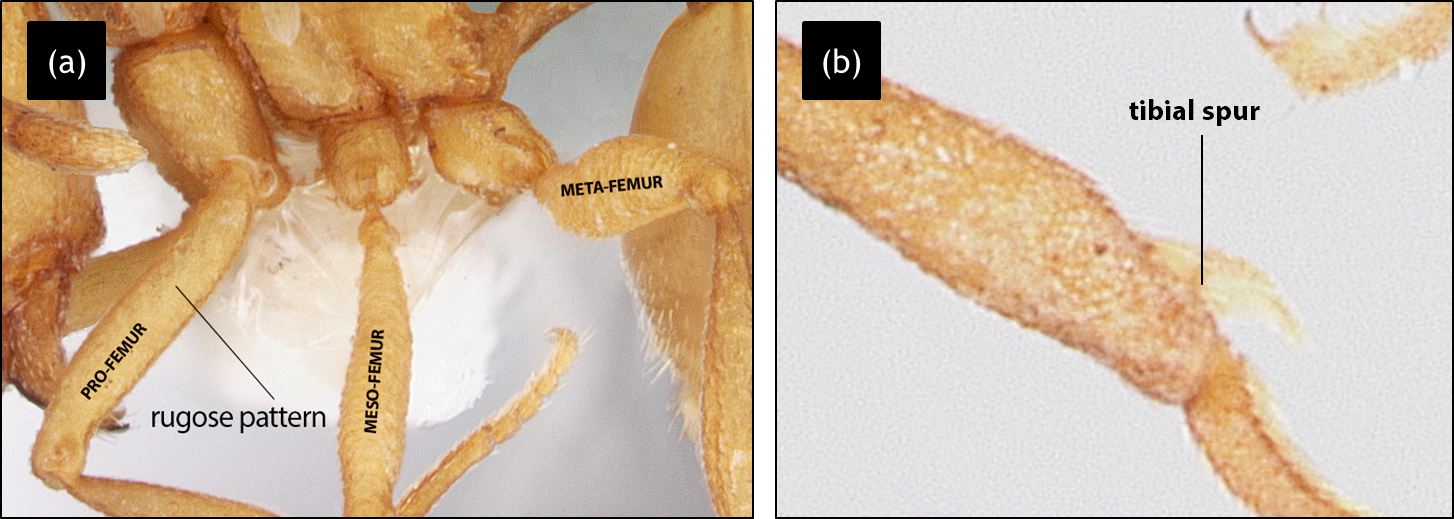
Table 2. Measured and calculated morphometrics measured from the workers in mm. Profemur length, pronotal width, meta-tibial length were excluded because of limitations in measuring these features. Some morphometrics n<8 because certain morphological features were obscured. PCA of the measured/calculated standard morphometrics did not show clustering between the different supposed proposal of ‘populations’ hypothesized.
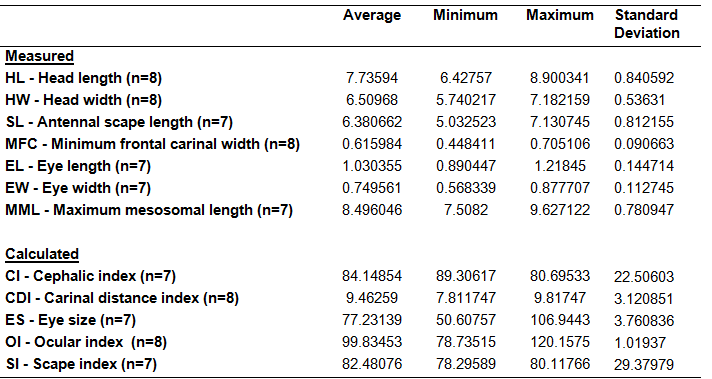
Female dealate gyne.
to be updated when information is available
Male.
to be updated when information is available

3.3 Physical specimens for reference
Syntypes (no holotype, lectotype unknown)
- Type locality: Sumatra, INDONESIA
Collected by: H. von Buttel-Reepen
Date collected: 26 Apr 1912
Currently at: Museo Civico Di Storia Naturale, Genoa, ITALY
Antweb link: http://www.antweb.org/specimenImages.do?name=casent0904973
- Type locality: Sumatra, INDONESIA
Collected by: H. von Buttel-Reepen
Date collected: unknown
Currently at: Museum d’Histoire Naturalle in Geneva, SWITZERLAND
Antweb link: http://www.antweb.org/specimen.do?name=casent0909355
- Type locality: Sumatra, INDONESIA
Collected by: H. von Buttel-Reepen
Date collected: unknown
Currently at: National Museum of Natural History, Smithsonian Institution, Washington D. C., USA
Catalogue number: 661177
GBIF link: http://data.gbif.org/occurrences/22600449
sources: Ant Web (2013); GBIF (2013)
Non-types
Table 3. Non-type specimens collated from Antweb.org sorted by chronology (refer to http://www.antweb.org/browse.do?genus=proatta&name=butteli&rank=species&project=allantwebants). Abbreviations used for the museums of storage and collection names are reflected below the table. A distributional map based on specimen locality is plotted out with Google Maps (below).
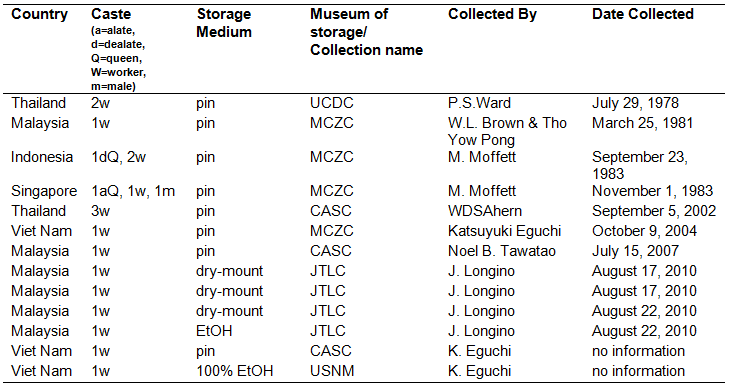
- UCDC - Bohart Museum of Entomology, University of California at Davis, CA, USA; searchable database @ http://museums.ucdavis.edu/bohart.aspx
- CASC - California Academy of Sciences, San Francisco, CA, USA
- USNM - National Museum of Natural History, Washington, DC, USA;searchable database @ http://collections.mnh.si.edu/search/
- MCZC -Museum of Comparative Zoology, Harvard University, Cambridge, MA, USA; searchable database @ http://mczbase.mcz.harvard.edu/SpecimenSearch.cfm
- JTLC - Jack Longino collection

Return to Table of ContentsYou just finished section [3] Taxonomy & Systematics

Glossary & Jargon
Formicidae
Morphology
- Epinotum: the upper surface of the altitrunk
- Frons*: the area above the clypeus, in the center of the head
- Frontal carina*: longitudinal ridges on the frons, behind the clypeus and between or often partly covering the antennal bases
- Frontal lobes*: lateral projection of the frontal carina
- Tubercles: rounded protrutions
- Trochanter, coxa, femur, tibia, tarsus and pretarsus (of legs): segments of the legs in order from the main body downwards
- Pretarsal claw*: a pair of claws on the pretarsus
- Tibial spur*: an articulated spine located on the apex of the tibia
- Basal margin* (of triangular mandibles): the mandibular margin the closest to the anterior clypeal margin
- Masticatory margin* (of triangular mandibles): the mandibular margin further from the anterior clypeal margin
- Pubescence^: small hairs you can see covering the ants body
- Pilosity^: the longer hairs, generally used for tactile perception, and they also play a role in development in aiding the removal of the pupal or larval skin
*terminology adapted from the Paraguayan Ant Project @ http://projects.biodiversity.be/ants/glossary/termsList (a great website for ant morphological terminologies with SEM images of ants)
^terminology adapted from http://jlibsch.web.wesleyan.edu/Ant/Morphology/Integument.html
Castes
- Ant alate: winged reproductive individuals, that can be either male or female
- Ant gyne: reproductive females which, are egg-laying. If they have found a nest, they are called ‘queens’.
- Ant worker: sterile females which make up the majority of the colony in typical ant colonies
- Monomorphic: (in ants) workers showing little or no variation in morphology or phenotype; only one subcaste of worker ants that morphologically similar both in size and form
Phenomena
- Colony founding: (in ants) the initial stage where the fertilized female alate has to find a nest
- Mutualistic: (in biology) a symbiotic relationship that is beneficial to both parties involved
- Polydomous: (in ants) multiple nests that function as a social and cooperative unit, sometimes having more than one queen
- Polygynous: (in ants) more than one fertile queen in a nest.
- Trophallaxis: (in ants) the transfer of fluids mouth-to-mouth
Evolution biology
- Convergence: the acquisition of similar traits due to independent evolution
- Homoplasy: a shared trait found among different taxa but is inferred to have been independently derived; a convergent trait
- Monophyletic: a clade that is inclusive of the common ancestor and all its descendents
- Monotypic: (in genus) one species in a genus
- Pleisomorphy: a shared trait found in two or more taxa, but also shared with a more distant remote common ancestor
- Polyphyletic: a group of organisms derived from more than one common evolutionary ancestor
- Synapomorphy: a character that is shared by two or more taxa and is inferred to have occurred in the most common ancestor
Biogeography
- Old World: a colloquial term that describes all the geographic regions other than the New World (North and South America)
Taxonomy
- Holotype (‘THE type’): the specimen from which the species was assigned by its describer
- Lectotype: the lectotype is the type specimen designated from the syntypes
- Neotype: a new specimen that has been designated as the type specimen as the non-type has been irreparably damage
- Paratype: a specimen that is designated as a type, alongside the holotype
- Syntype(s): a select few specimen that is designated as the type specimen for the particular species; possible where there is no clear holotype specimen

References
Taxonomic descriptions of species
- Proatta butteli Forel, 1912: p. 769. Original description of worker.
- Proatta butteli Forel: Forel, 1913: p. 86. Incorrectly indicated as new species.
- Proatta butteli Forel: Emery, 1924. Placed in the tribe Attini.
- Proatta butteli Forel: Crawley, 1924. Description of gyne.
- Proatta butteli Forel: Wheeler and Wheeler, 1985. Description of larvae.
- Proatta butteli Forel: Moffet, 1986. Additional description of gyne.
Taxonomic treatment of genera (with subsequent changes underlined)
- Proatta in subfamily Myrmicinae, tribe Proattini: Forel, 1912: 246; Wheeler, W.M. 1922: p. 668; Wheeler, G.C. & Wheeler, J. 1985: p. 257.
- Proatta in subfamily Myrmicinae, tribe Attini: Emery, 1913: 251; Emery, 1914: p. 42; Emery, 1924: p. 333 [subtribe Proattini]; Donisthorpe, 1943: 686; Chapman & Capco, 1951: 83.
- Proatta in subfamily Myrmicinae, tribe Pheidolini: Dlussky & Fedoseeva, 1988: p. 80
- Proatta in subfamily Myrmicinae, tribe Stenammini: Bolton, 1995: p. 106; Bolton, 2003: p. 59.
Taxonomic records of species
- Proatta butteli Forel: Viehmeyer, 1916: p. 140. Distribution (SINGAPORE).
- Proatta butteli Forel: Emery, 1924: p. 334. Cataloged (worldwide).
- Proatta butteli Forel: Crawley, 1924: p. 401. Description, distribution (Sumatra, INDONESIA).
- Proatta butteli Forel: Chapman & Capco, 1951: p. 83. Distribution (Asia).
- Proatta butteli Forel: Bolton, 1995: p. 366. Cataloged (worldwide).
- Proatta butteli Forel: Jaitrong, 2004: p. 33. Cataloged (THAILAND).
Works cited
Internet Resources (denoted by e)
[e1] “Proatta distribution,” by AntWiki Contributors. AntWiki, 10 Oct 2012. URL: http://www.antwiki.org/wiki/File:Proatta_Distribution.png (accessed on 23 Aug 2013).
[e2] “Ant Web,” by Californica Academy of Sciences. California Academy of Sciences, 2013. URL: http://antweb.org (accessed 30 Oct 2013).
[e3] “Ant Base,” by Pfeiffer, M. University of Elm, 2013. URL: http://antbase.net (accessed 11 Dec 2013).
[e4] “Map of Sunda and Sahul shelf,” by Dörrbecker, M.. Wikipedia, 25 Jul 2009. URL: http://en.wikipedia.org/wiki/File:Map_of_Sunda_and_Sahul.png (accessed 23 Aug 2013).
[e5] “Alex Wild Photography: Proatta butteli,” by Wild, A.. Alex Wild Photography. URL: http://www.alexanderwild.com/Ants/Taxonomic-List-of-Ant-Genera/Proatta/i-tDxCrkQ/A (accessed 23 Aug 2013).
[e6] “Myrmicine morphology”, by Shattuck, S.. Ant Wiki, 16 Jun 2012. URL: http://www.antwiki.org/wiki/File:GlossaryAntMyrmicine.jpg on 4 Oct 2013.
[e7] “Head morphology”, by Shattuck, S.. Ant Wiki, 16 Jun 2012. URL: http://www.antwiki.org/wiki/File:GlossaryAntFrontHead.jpg (accessed on 23 Aug 2013).
[e8] “Morphological and Functional Diversity of Ant Mandibles,” by Schmidt, C. A.. Tree of Life Project, 2004. URL: http://tolweb.org/treehouses/?treehouse_id=2482 (accessed on 23 Aug 2013).
[e9] “Simple eye in invertebrates,” by Wikipedia. Wikipedia, 14 Oct 2013. URL: http://en.wikipedia.org/wiki/Simple_eye_in_invertebrates (accessed 27 Sep 2013). (note: this Wikipedia page was only cited because it had well-substantiated citations and has an online link for easy reference)
[e10] “A plague of deforestation sweeps across Southeast Asia”, by Daniel Drollette, Yale Environment 360, 20 May 2013. URL: http://e360.yale.edu/feature/a_plague_of_deforestation_sweeps_across_southeast_asia/2652/ (accessed 8 Nov 2013).
[e11] “IUCN Red List of Threatened Species,” by IUCN. IUCN, 2013. URL: http://www.iucnredlist.org/ on 23 Aug 2013.
[e12] “Ants and the Red List,” by John Fallowes and Carsten Brühl, ANeT 2009. URL: http://www.asian-myrmecology.org/ANeT-09/bruehl/IUCN_red_list_ants_introduction.pdf (accessed 12 Nov 2013).
[e13] “Architecture avoids flooding, creates microclimate: ants,” by The Biomimicry Project. Ask Nature, 23 Sep 2013. URL: http://www.asknature.org/strategy/64a8bee94641050bdd4f208e2250f65a (accessed on 29 Oct 2013).
[e14] “Stenammini,” by Bionames. Bionames, 2013. URL: http://bionames.org/trees/phylota/ti144019_cl5_db184 (accessed 30 Sep 2013).
[e15] “Formicidae,” by Bionames. Bionames, 2013. URL: http://bionames.org/taxa/ncbi/36668 (accessed on 30 Sep 2013).
[e16] “Formicidae”, by Tree of Life. Tree of Life. Tree of Life Project, 2004. URL: http://tolweb.org/Formicidae (accessed on 30 Sep 2013).
[e17] “Formicidae,” by Bionames. Bionames, 2013. URL: http://bionames.org/taxa/ncbi/36668 (accessed on 30 Sep 2013).
[e18] “Male ants demystified,” by Boudinot, B.. Myrmecos blog, 9 Sep 2013. URL: http://myrmecos.net/2013/09/09/male-ants-demystified/ (accessed on 28 Sep 2013).
Print Publications and/or Journal Papers (includes taxonomic references) (denoted by p)
[p1] Moffet, M. W. (1986). Behaviour of group-predatory ant Proatta butteli (Hymenoptera: Formicidae): an old world relative of the attine ants. Insect Sociaux, 33(4): 444-457.
[p2] Moffet, M. W. (2011). Adventures among Ants: A Global Safari with a Cast of Trillions. (Moffet, M. W., Eds.). University of California Press. Berkley, California.
[p3] Forel, A. (1912). Descriptions provisoires de genres, sous-genres, et especes de Formicides des Indes orientales. Rev. Suisse Zool., 20: 761–774.
[p4] Bolton, B. (1994). Identification guide to the ant genera of the world. (B. Bolton, Ed.) (p. 222). Cambridge, Massachusetts: Harvard University Press.
[p5] Xu, Z. H. (2012). Gaoligongidris planodorsa, a New Genus and Species of the Ant Subfamily Myrmicinae from China with a Key to the Genera of Stenammini of the World (Hymenoptera: Formicidae). Sociobiology, 59(2): 331–342.
[p6] Guenard, B. (2011). Ant Diversity, from Local to Global Scales: Effects of Environmental Conditions, Community Structure and Biological Invasions. North Carolina State University.
[p7] Chapman, J. W., & Capco, S. R. (1951). Check list of the Ants (Hymenoptera: Formicidae) of Asia. Monographs of the Institute of Science and Technology, 1, 1–307.
[p8] Harrison T., Krigbaum J. & Manser J. (2006). Primate biogeography and ecology on the Sunda Shelf Islands: a paleontological and zooarcheological perspective. (Lehman S. M. and Fleagle J. G. Eds.) Primate biogeography: progress and prospects. New York: Springer. 331–372.
[p9] Ness, J. (2010). Ant Ecology: Ants as mutualists. (L. Lach, C. Parr, & K. Abbott, Eds.). Oxford University Press, USA.
[p10] Holldobler, B., & Wilson, E. O. (1990). The ants. Harvard University Press. Cambridge, Massachusetts.
[p11] Barnard, C. J. (2004). Animal Behaviour: Mechanism, Development, Function and Evolution. Pearson Education.
[p12] Wheeler, W. M. (1915). On the presence and absence of cocoons among ants, the nest-spinning habits of the larvae and the significance of the black cocoons among certain Australian species. Annals of the Entomological Society of America, 8, 323–342.
[p13] Lorite, P. & Palomeque, T. (2010). Karyotype evolution in ants (Hymenoptera: Formicidae), with a review of the known ant chromosome numbers. Myrmecological News, 13, 89– 02.
[p14] Wheeler, G. C., & Wheeler, J. (1986). The larva of Proatta (Hymenoptera: Formicidae). Psyche, 92, 447–450.
[p15] Lee, C. Y., & Tan, E. K. (2004). Guide to Urban Pest Ants of Singapore. (C. Y. Lee & E. K. Tan, Eds.). Singapore Pest Managment Association.
[p16] Hefetz, A. (2007). The evolution of hydrocarbon pheromone parsimony in ants (Hymenoptera: Formicidae) – interplay of colony odor uniformity and odor idiosyncrasy. A review. Myrmecological News, 10: 59-68.
[p17] Akino, T., Yamamura, K., Wakamura, S. & Yamaoka, R. (2004). Direct behavioural evidence for hydrocarbons as nest-mate recognition cues in Formica japonica (Hymenoptera: Formicidae). Applied Entomology and Zoology, 39, 381-387.
[p18] Tsutsui, N. D. & Suarez, A. V. (2002). Population biology of invasive ants. Conservation Biology, 17(1): 48-58.
[p19] Crawley, W. C. (1924). Ants from Sumatra. Annals and Magazine of Natural History, 13: 380–409.
[p20] Akino, T. (2008). Chemical strategies to deal with ants: a review of mimicry, camouflage, propaganda and phytomimesis by ants (Hymenoptera: Formicidae) and other arthropods. Myrmecological News, 11, 173-181.
[p21] Traniello, J. F. (1989). Foraging strategies of ants. Annual Review of Entomology, 34(1): 191–210.
[p22] Ward, P. S. (2007). Phylogeny, classification, and species-level taxonomy of ants. Zootaxa, 1668: 549-563.
[p23] Yek, S. H. & Mueller, U. G. (2010). The metapleural gland of ants. Biological Reviews, doi: 10.1111/j.1469-185X.2010.00170.x.
[p24] Mueller, U. G., Schultz, T. R., Currie, C. R., Adams, R. M. M., & Malloch, D. (2001). The Origin of the Attine Ant-Fungus Mutualism. The Quarterly Review of Biology, 76(2): 169–197.
[p25] Holldober, B., & Wilson, E. O. (2010). The Leafcutter Ants: Civilization by Instinct. W. W. Norton & Company.
[p26] Schultz, T. R. & Meier, R. (1995). A phylogenetic analysis of the fungus-growing ants (Hymenoptera: Formicidae: Attini) based on morphological characters of the larvae. Systematic Entomology, 20, 337–370.
[p27] Schultz, T. R., & Brady, S. G. (2008). Major evolutionary transitions in ant agriculture. PNAS, 105(14): 5435–5440.
[p28] Bolton, B. (2003). Synopsis and classification of Formicidae. Memoirs of the American Entomological Institute, 71, 1–361.
[p29] Brady, S. G., Schultz, T. R., Fisher, B. L., & Ward, P. S. (2006). Evaluating alternative hypotheses for the early evolution and diversification of ants. PNAS, 182, 18172–18177.
[p30] Sanderson, M. J., Boss, D., Chen, D., Cranston, K. A. & Wehe, A. (2008). The PhyloTA browser: process GenBank for Molecular Phylogenetics Research. Systematic Biology, 53(3), 335–467.
[p31] Mueller, U. G., Schultz, T. R., Currie, C. R., Adams, R. M. M., & Malloch, D. (2001). The Origin of the Attine Ant-Fungus Mutualism. The Quarterly Review of Biology, 76(2): 169–197.
[p32] Wheeler, Q. D. & Platnick, N. I. (2000). The Phylogenetic Species Concept in Species Concepts and Phylogenetic Theory. (Wheeler, Q. & Meier, R., Eds.). Columbia University Press. New York, New York.
[p33] Weber, N. A.. (1958). Nomenclatural notes on Proatta and Atta (Hymenoptera: Formicidae). Entomological News, 69(1): 1–13.
[p34] Cox, B. & Moore, P. (2010). Biogeography: an ecological and evolutionary approach: 8th edition. (Cox, B. and Moore, P., Eds.) John Wiley and Sons.
[p35] Johnson, B., Borowiec, M. L., Chiu, J. C., Lee, E. K., Atallah, J. & Ward, P. S. (2013). Phylogenomics resolves evolutionary relationships amongst Ants, Bees and Wasps. Current Biology, 23: 1-5.
[p36] Moreau, C. (2006). Phylogeny of the Ants: Diversification in the Age of Angiosperms. Science, 312: 101–103.
[p37] Harris, R. (1979). A Glossary of Surface Sculpturing. Occasional Papers in Entomology, 28, 1-31.
[p38] Wild, A. L. (2007). Taxonomic revision of the ant genus Linepithema (Hymenoptera: Formicidae). University of California Press, 126: 1–120.
[p39] Gotzek, D., Brady, S. G., Kallal, R. J., & LaPolla, J. S. (2011). The Importance of Using Multiple Approaches for Identifying Emerging Invasive Species: The Case of the Raspberry Crazy Ant in the United States. PlosONE, 7(9): e45314.
[p40] Forel, A. (1913). Wissenschaftliche Ergebnisse einer Forschungsreise nach Ostindien ausgefuhrt im Auftrage der Kgl. Preuss. Akademie der Wissenschaften zu Berlin von H. v. Buttel-Reepen. II. Ameisen aus Sumatra, Java, Malacca und Ceylon. Gesammelt von Herrn Prof. Dr. v. Bu. Zoologische Jahrbucher. Abteilung fur Systematik, Geographie und Biologie der Tiere, 36: 1–148.
[p41] Emery, C. (1924). Hymenoptera. Family Formicidae. Subfamily Myrmicinae. [concl.]. Genera Insectorum, 174C: 207–397.
[p42] Donisthorpe, H. (1943). A list of the type-species of the genera and subgenera of the Formicidae. Annals and Magazine of Natural History, 11(10): 617–688.
[p43] Wheeler, W. M. (1922). Formicidae from Easter Island and Juan Fernandez in The Natural History of Juan Fernandez and Easter Island. Volume III. Zoology. (C. Skottsberg, Ed.). Almqvist and Wiksells.
[p44] Emery, C. (1913). Etudes sur les Myrmicinae. [V-VII]. Annals of the Society of Entomology of Belgium, 57: 250–262.
[p45] Emery, C. (1914). Intorono alla classificazione dei Myrmicinae. Rend. Sess. R. Acad. Sci. Ist. Bologna Cl. Sci. Fish., 18: 29–42.
[p46] Dlussky, G. M., & Fedoseeva, E. B. (1988). Origin and early stages of evolution in ants: Cretaceous biocenotic crisis and insect evolution. (A. G. Ponomarenko, Ed.). Moskva, Nauka.
[p47] Bolton, B. (1995). Catalogue of ants of the world. Harvard University Press. Cambridge, MA.
[p48] Viehmeyer, H. (1916). Ameisen von Singapore. Beobachtet und gesammelt von H. Overbeck. Archiv für Naturgeschichte, 81: 108–168.
[p49] Jaitrong, W., & Nabhitabhata, J. (2005). A list of known ant species in Thailand. The Thailand Natural History Museum Journal, 1(1): 9–54.

Useful Resources
Specific to Proatta butteli
- Proatta butteli on EOL: http://eol.org/pages/403518/details
- Proatta butteli on GenBank: http://www.ncbi.nlm.nih.gov/Taxonomy/Browser/wwwtax.cgi?id=369213
- Proatta butteli on BioNames: http://bionames.org/search/Proatta+butteli
- Proatta butteli on GBIF: http://data.gbif.org/species/1326944/
- Proatta butteli on AntCat: http://www.antcat.org/catalog/429658
- Proatta butteli on Alex Wild’s blog: http://myrmecos.net/2010/09/07/answer-to-the-monday-night-mystery-proatta-and-the-attines/
- Proatta butteli on Ants and Termites of Malaysia blog: http://termitesandants.blogspot.sg/2009/10/proatta-butteli.html

Other Ant Sites
- AntWeb, a great database for ants: http://antweb.org/
- Paraguay Ant Project, a great example of a country-based database for ants: http://projects.biodiversity.be/ants/
- Tree of Life (Formicidae), a page to chart the phylogenetic relationships of ants: http://tolweb.org/formicidae/
- Encyclopedia of Life (Formicidae), a page to document the species within Formicidae: http://eol.org/pages/699/overview
- Hymenoptera Name Server, a database to check up-to-date names of ants: http://atbi.biosci.ohio-state.edu/hymenoptera/nomenclator.name_entry?
- Global Ant Project, a site dedicated to famous ant taxonomists: http://gap.entclub.org/taxonomists/
- AntCat, a site with many of the ant literature, sorted by taxa and publication: http://antcat.org/
- Hymenoptera Online, a database for Hymenopteran taxa and literature: http://hol.osu.edu/
- Wikipedia: Queen Ants, a page on queen ants: http://en.wikipedia.org/wiki/Queen_ant
- Hymenoptera Anatomy Ontology Portal, a database glossary for hymenopterans: http://portal.hymao.org/projects/32/public/ontology/
- Ant Plant mutualisms, by Jack Longino a prominent ant taxonomist: http://academic.evergreen.edu/projects/ants/ANTPLANTS/CECROPIA/Cecropia.html
Ant Resources, just for KIDS!
- Ask a Biologist about Ants, a page for kids about ant anatomy: http://askabiologist.asu.edu/explore/ant-anatomy
- Ant Blog, ask ant experts any question about ants: http://www.antweb.org/antblog/ask-an-ant-expert/
- School of Ants, a platform for children to participate in citizen science: http://schoolofants.org/
- Dr. Eleanor’s Book of Common Ants, a book for the common ants of North America: http://www.yourwildlife.org/ibook-of-common-ants/
- The Ant Kingdom, a cute site for kids about ants by Japanese creators: http://ant.edb.miyakyo-u.ac.jp/BE/Kingdom/0203/0203e.html
- (AWESOME) Ant comic, written by various people as a PDF: http://ants.yourwildlife.org/wp-content/uploads/myrmex_comic.pdf
Other Insect Sites
- Bug Guide, a site with layman diagnoses of insects: http://bugguide.net/
- Glossary of Phylogenetic Systematics, on an Odonata phylogeny mapping site: http://www.bernstein.naturkundemuseum-bw.de/odonata/glossary.htm
- Wikipedia: Insect Morphology, a page on insect morphology terminologies: http://en.wikipedia.org/wiki/Insect_morphology
- Wikipedia: Insect Wing, a page on insect wing morphology terminology and development: http://en.wikipedia.org/wiki/Insect_wing
Relevant Journals and Databases
- GenBank, a database of genetic sequences of animal and plants: http://www.ncbi.nlm.nih.gov/genbank/
- Myrmecological News, a journal that publishes science to do with ants: http://myrmecologicalnews.org/cms/
- Sociobiology, a journal that publishes mainly on social insects: http://www.csuchico.edu/biol/Sociobiology/sociobiologyindex.html
- Zootaxa, a journal that publishes taxonomic descriptions: http://www.mapress.com/zootaxa/taxa/Hymenoptera.html
- Zookeys, another journal that publishes taxonomic descriptions: http://www.zookeys.net
- GBIF, a database for all biodiversity: http://data.gbif.org/welcome.htm
- Biodiversity Heritage Library, a database for old biodiversity-related papers: http://www.bhl.org
- iNaturalist, a volunteer-based database of sighting of biodiversity, http://inaturalist.org
- Berkley: the various species concepts, http://evolution.berkeley.edu/evosite/evo101/VA1BioSpeciesConcept.shtml
Phylogenetics and Trees
- PhyloTree, a way to visualize phylogenetic trees developing in time: http://www.brown.edu/Faculty/Dunn_Lab/phylotree
- PhyloTA, a database of phylogenetic trees of taxa sequenced: http://phylota.net/cgi-bin/sql_getdesc.cgi?c=0&ti=36668&mode=0&db=194
Other Ant Pages on LSM4254 Species Pages
- The Asian Weaver Ant, Oecophylla smaragdina, by Reuben Lim: http://taxo4254.wikispaces.com/Oecophylla+smaragdina
For Further Reading
- Bolton, B. (1994). Identification guide to the ant genera of the world. (B. Bolton, Ed.) (p. 222). Cambridge, Massachusetts: Harvard University Press.
- Holldobler, B., & Wilson, E. O. (1990). The ants. Cambridge, MA: Harvard University Press.
- Holldober, B., & Wilson, E. O. (2010). The Leafcutter Ants: Civilization by Instinct. W. W. Norton & Company.
- Jolivet, P. (1996). Ants and Plants: An example of coevolution. Backhuys Publishers. Leiden, The Netherlands.
- Bolton, B. (2007). How to conduct large-scale taxonomic revisions in Formicidae. Memoirs of American Entomological Institute, 80, 52-71.

Page Conceptualisation
A page started by Soh Jia Yu, Eunice* on taxo4254.wikispaces.com - a student-driven initiative for LSM4254 - Taxonomy and Systematics of the Department of Biological Sciences, National University of Singapore.
The Proatta butteli Forel 1912 species page contains three major sections, covering the ‘General Information’, ‘Natural History and Biology’, and the ‘Taxonomy and Systematics’ with the Glossary, References and Useful Resources sections meant to supplement the three main sections. The last section on Page Conceptualisation documents the page building process with technical details. As with every Wiki page, it is a work-in-progress and subject to updates. The best way to utilize this page is to navigate to the areas in which you have a personal interest in -- via the 'Table of Contents'. Effort is made to link what is unique to the Proatta butteli ant to popular themes in ant ecology and biology. To summarize lengthy sections, a haiku is written in a speech bubble.
This page may be cited as follows:Soh, E. J. Y. (2013)*. National University of Singapore LSM4254 Species Pages for Proatta butteli (Hymenoptera: Formicidae). Retrieved from http://taxo4254.wikispaces.com/Proatta+butteli on DD MMM YYYY.
*subject to change, if edits by another person is made. The initial author gives subsequent Wiki pages editors the right to change the content of this page,where information is wrong or updated or if there is new information found on the species.
Software used: Microsoft Word 2010 (for text editing), Adobe Photoshop CS6, Adobe Illustrator CS6 (for graphics), Adobe Flash CS6,Jabref Version 2.9.2 (for Bibtex management), Mendeley Desktop 1.10.1 (for generating citations)
Third-party API: YouTube, Google Maps, iNaturalist, Hymenoptera Online
Page conceptualisation:
Proatta butteli scr.txt
Documentation of updates:
- 28 Aug 2013 – initial creation and conceptualization of the page, adding in information from literature, by Eunice Soh
- 21 Sept 2013 – updated taxonomic description, by Eunice Soh
- 27 Sept 2013 – added in information about 2.1, Glossary as well as navigational links and widgets (iNaturalist, You Tube) within the page, by Eunice Soh
- 30 Sept 2013 – added in more information about phylogenetic position, by Eunice Soh
- 3 Oct 2013 – ant links for kids added, by Eunice Soh
- 22 Nov 2013 – addition of haikus to make the page more reader-friendly, by Eunice Soh
- 12 Dec 2013 – minor changes and addition of anchors, by Eunice Soh

Your Comments
If you’d like to make comments/suggestions about the page, please drop a comment here or contact me (Eunice Soh) at eunice.sjy@gmail.com. Any comments/suggestions are most appreciated!
| Subject | Author | Replies | Views | Last Message |
|---|---|---|---|---|
| Comment added: | 0 | 62 |
Oct 25, 2013 by |


